By now, we’ve all heard how social media can support a brand and make it easier to connect with customers. But not all of us have the benefit of being a consumer-facing brand like Pepsi, Domino’s, or Oreo. If you’re representing a B2B brand, can you still take advantage of social media? Absolutely!
Is your brand new to social media? Grab a copy of our free eBook: How to adapt your brand to social media
As a follow-up to one of our most popular posts, here are 10 of our favorite examples of B2B brands using social media to build their brands and make an impact online.
10. Build brand awareness: MailChimp on Instagram
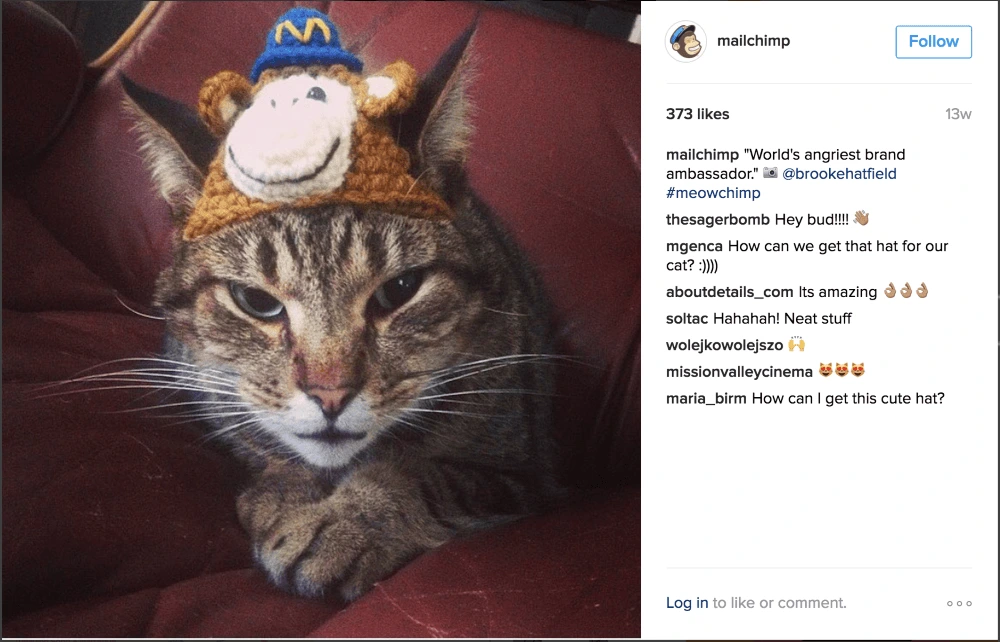
If you take a cursory glance at MailChimp’s Instagram account, one thing is immediately clear: That gosh-dang monkey is everywhere. (Forgive my crude Utah language.) But there’s a good reason for it. “Freddie” the monkey has been MailChimp’s loyal brand ambassador since the beginning, and while he’s gone through a few changes over the years, his fun personality still shines through.
As a visual platform, Instagram is specially suited to sharing Freddie’s shenanigans and encouraging MailChimp fans to do the same. From figurines to knitted caps, he is a constant reminder of the brand without being too ‘on the nose’, and he keeps MailChimp top-of-mind for its followers. (Bonus tip? On the internet, you can never go wrong with cats.)
9. Show off your expertise: Huawei on Twitter

Huawei is the largest manufacturer of telecommunications equipment in the world. Yet, if you asked the average American, it’s unlikely they’d know much about this giant company headquartered in China. That hasn’t stopped the brand from embracing social media in various countries and building up an appreciative audience for its content.
Huawei spotlights innovative technology trends and predictions for the future, inviting experts to weigh in on the tough questions (“Can AI ever function like a human?”) that make for rich conversations. Its Twitter timeline is chock-full of thought-provoking quotes from industry leaders.
By taking the time to create smart, dense content, Huawei sets itself apart from other social media accounts who find it easier to keep things fluffy.
8. Join relevant groups: Lucidpress on LinkedIn
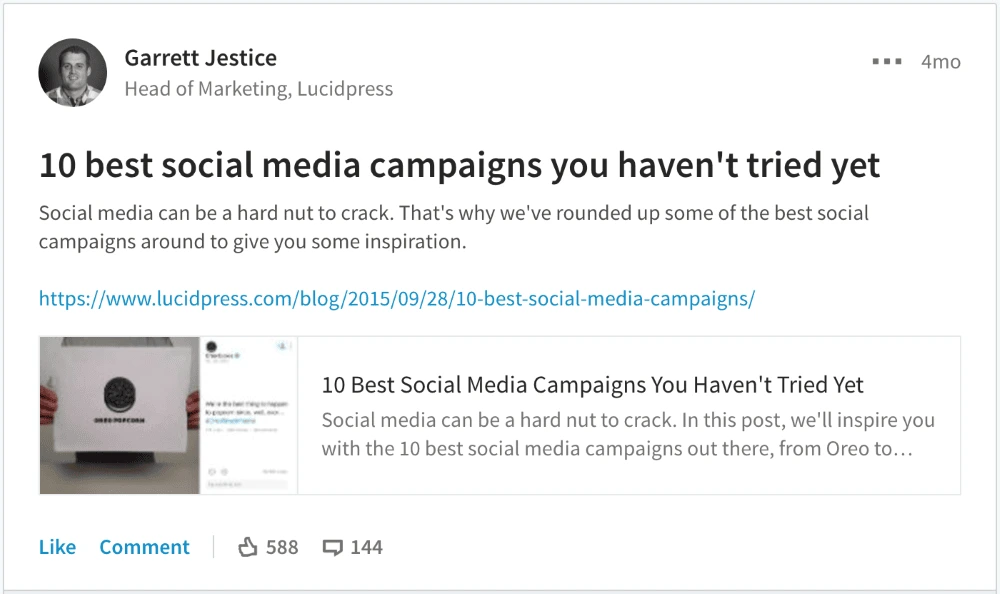
If we want to talk the talk, we’d better walk the walk.
Although Lucidpress isn’t strictly a B2B brand, we serve a large number of businesses who use Lucid’s software across various departments. To reach these businesses, we have found that it’s better to go where your audience is than to expect it to come to you. One way to do that is to join relevant LinkedIn groups and share your content with them. It’s this strategy that likely brought many of you here today, as a follow-up to one of our most successful LinkedIn conversations.
Due to the many comments and feedback in that conversation, we realized there was a content need we were not filling (that is, looking at social media from a B2B perspective), and it gave us the opportunity to serve our B2B users better.
7. Share your human side: Novartis on Facebook

As a B2B brand, it can be difficult to express humanity online. What I mean by that is a corporation can start to feel like a faceless monolith (“We appreciate your business”) when compared to real, one-on-one connections with other people (“I’m so glad you called!”).
Novartis, the multinational pharmaceutical company, has found a wonderful way to remind us that organizations are made up of real people with unique stories and goals, by spotlighting individuals who work or intern there on its Facebook page.
The best part about this strategy is that any brand can use it, because every brand has fascinating people working behind the scenes. Take a look around your office and see who’s got a story to tell. We guarantee your users will relate and respond far better to that than to your next press release.
6. Create a community: American Express on Twitter
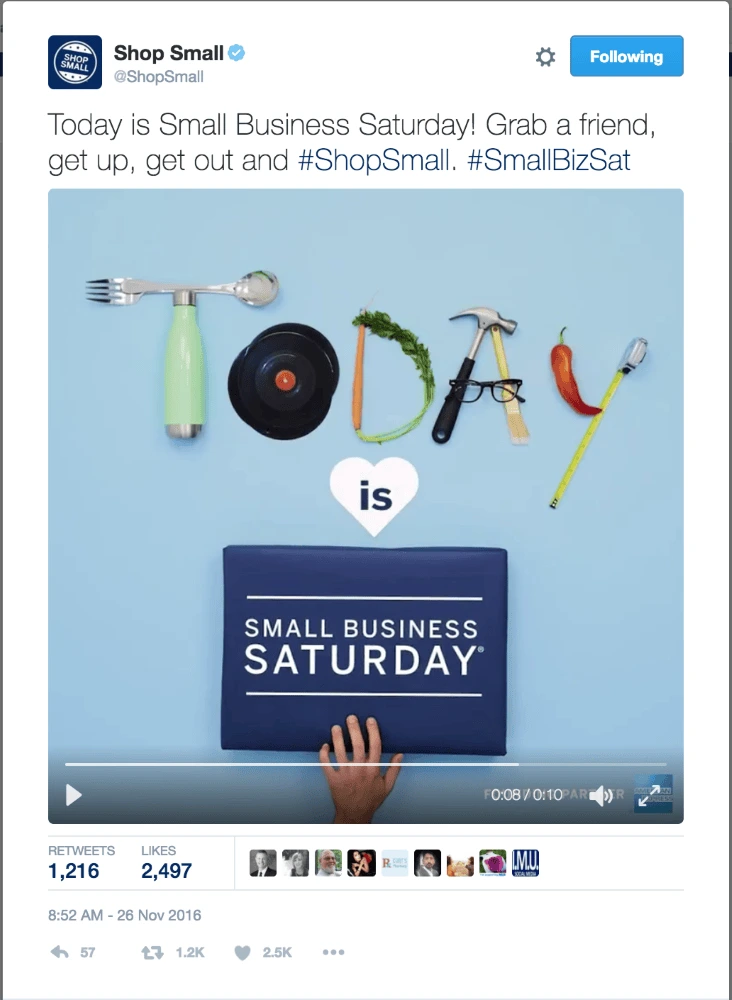
American Express has been recognized in the past for OPEN Forum, its small-business blog—and rightly so. But its dedication to serving SMBs crossed over into social media with the creation of the @ShopSmall Twitter account. @ShopSmall is active throughout the year, but things really ramp up in the fall in preparation for November’s #SmallBizSat.
If you haven’t heard, Small Business Saturday is a national holiday (first sponsored by American Express in 2010) that takes place between Black Friday and Cyber Monday. It encourages shoppers to support small and local businesses—just the kind of places American Express hopes to service.
@ShopSmall is a hyper-focused social media account that leverages the larger SMB community American Express has built over the years, and the community’s passion and enthusiasm are contagious.
5. Highlight user-created content: Maersk on Instagram

What do you get when you combine smartphone photography, shipping containers, and the open sea? For Maersk, the world’s largest container ship and supply vessel operator, you get one hell of an Instagram account. Thanks to pilots, sailors, and travel professionals around the world, Maersk has a deep well of user-generated photos to share with its 77.4k followers.
And the pictures are good. Like, really good. If you had told me that one of the best business Instagram accounts out there specialized in photos of shipping containers, I’m not sure you could’ve convinced me. But after scrolling past sun-lit ocean horizons, grand heavy ships that miraculously still float, and even the occasional double rainbow… I’m a believer.
(And, like Maersk, if you decide to use this tactic for your social media, don’t forget to credit the awesome folks who create branded content for you.)
4. Feature your customers: Square on Facebook
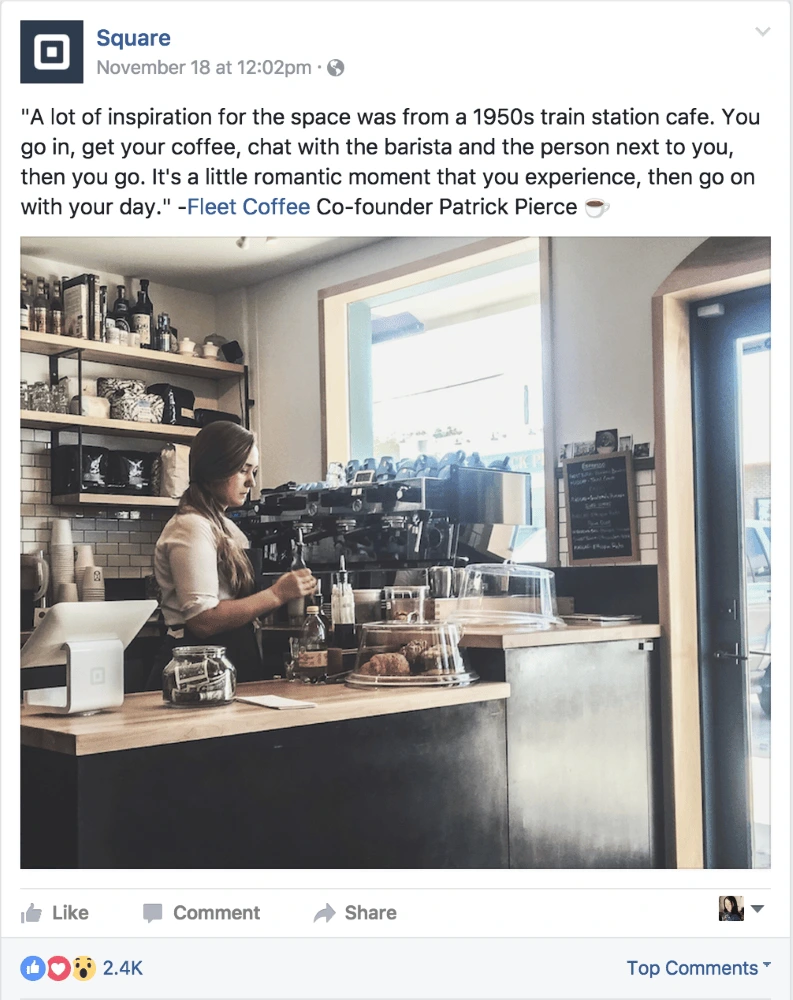
Like we learned from the Novartis example, stories about real people are compelling. But rather than turning its focus within, Square looks out towards its customers for social media inspiration.
Its Facebook page features slice-of-life photos of small businesses and the people who own them, people who depend on Square for payment processing. Next to the photo is a quote handpicked from a longer interview, where you get a glimpse into the daily lives of SMB owners around the country.
In this example, Fleet Coffee in Austin, Texas, is tagged so readers can easily visit their page. It’s not hard to imagine that this feature brought Fleet Coffee a few new followers—which is a nice way for Square to give a little bit back to the folks who keep them in business.
3. Display your culture: Intuit on LinkedIn
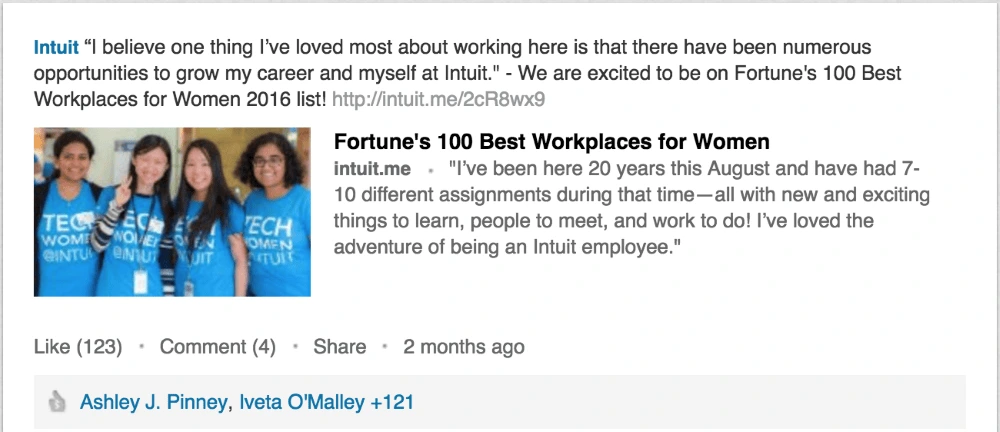
Got a company culture that you’re proud of? Share it! LinkedIn is the network of choice for business professionals, which means it’s the perfect place to share updates about awards, activities, and other exciting announcements pertaining to your company. As you can see in this update, the award shows that Intuit values a diverse culture that offers opportunities to women in tech.
Sharing what makes your company a great place to work offers dual benefits. First, it assures potential B2B clients and partners that you care about your people and will likely work hard to treat them fairly. Second, it attracts top talent who shares your values, which makes it easier to keep your culture strong. So don’t be shy—when it comes to culture, it’s okay to brag a little bit.
2. Give a peak behind the curtain: Sunnybrook Hospital on Twitter
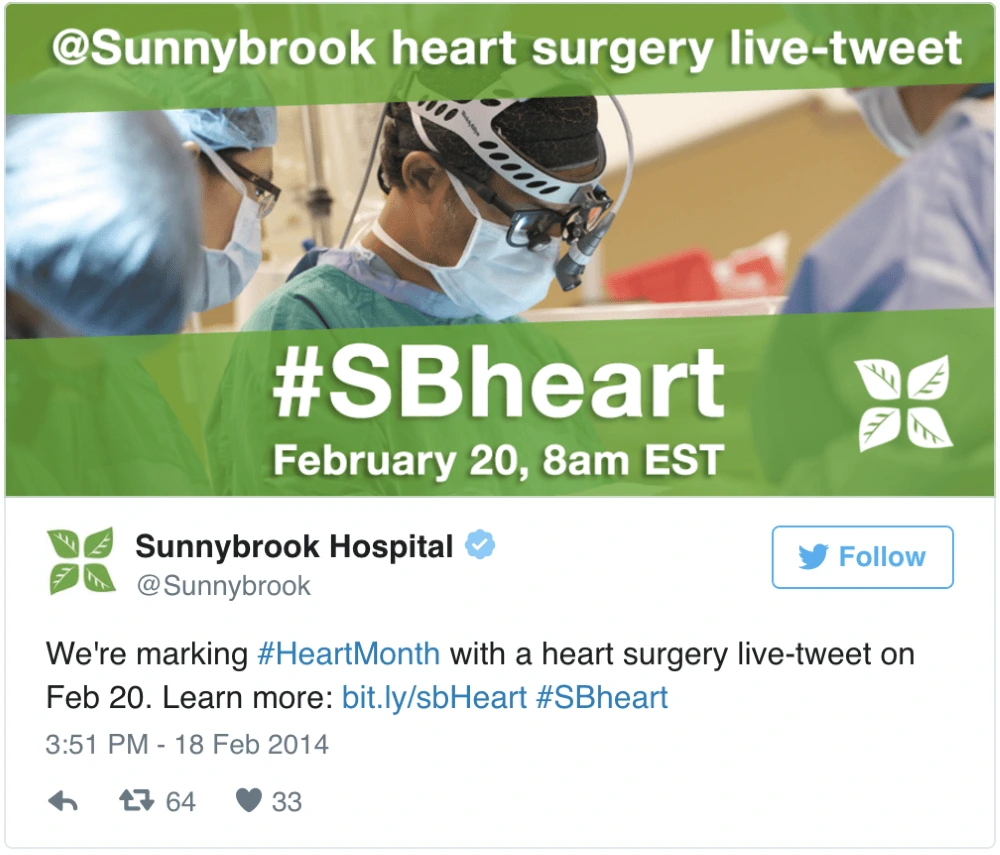
As you go about your daily work, consider that what might seem like regular routine to you could be fascinating and new for your audience. For example, take a look at the healthcare industry. Sunnybrook Hospital in Toronto, Ontario, came up with a fascinating way to give its followers a peak behind the curtain—by livetweeting a patient’s heart surgery.
As part of its efforts to raise awareness for Heart Month in February, the hospital livetweeted a coronary artery bypass graft over the course of nearly eight hours (with consent from the patient, of course). This unique use of social media attracted media coverage for their cause, which means the surgery and the strategy were both a great success.
To see the tweets, check out this Storify link (be advised: some tweets contain graphic medical content). Are there processes or procedures going on “behind the scenes” that you could share with your followers?
1. Don’t be afraid to try something new: General Electric on Instagram (Stories)
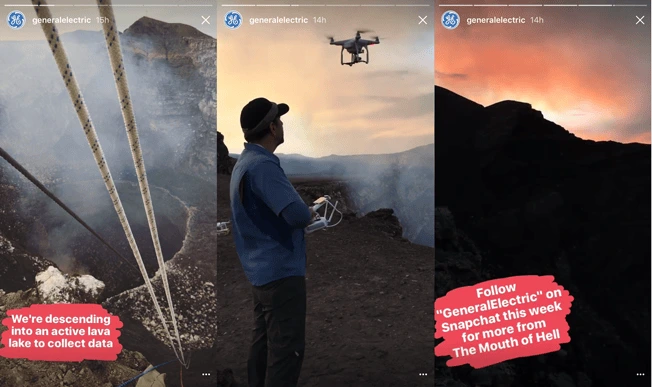
It’s almost impossible to talk about B2B social media without mentioning General Electric. The digital/industrial giant maintains a presence on all the major social networks and has earned praise for campaigns in the past like #ILookLikeAnEngineer, which highlighted women and minorities working in a white-male-dominated field. But what earns GE a spot on this list is not what they do on Facebook or Twitter.
It’s the willingness to experiment with new forms of social media, trying out innovative content and new platforms that might scare other brands away. GE was on Vine the day after it launched, it’s on Snapchat, and when Instagram launched Stories in August, GE was there with an exploration of the Masaya Volcano in Nicaragua.
While it might not keep or update every platform, GE strikes while the iron is hot and earns valuable views in the process.
It turns out that, with a little ingenuity, B2B brands can make just as big a splash on social media as any other brand. Next time you’re planning a social media campaign, try out some of these ideas. Did we miss any of your favorites? Share them in the comments below!
Is your brand new to social media? Grab a copy of our free eBook: How to adapt your brand to social media
Instagram is the second-most popular social media platform, following Facebook. Currently, this photo-sharing platform has more than 700 million users and gets more than 4.2 million likes on its posts every day.
And since Instagram has opened its floodgates for businesses to advertise on the platform, marketers are jumping at the opportunity to appear in the news feeds of their target customers. And why wouldn’t they? A study conducted at the end of 2016 claimed that Instagram has 20x more engagement than Twitter and 15x more than Facebook.
Related: Free Instagram post templates
However, it’s also true that many businesses are failing to convince Instagram’s proactive and highly engaged user base to tap their advertisements. And it’s not just small brands—big names like Coca-Cola, Victoria’s Secret and McDonald’s also fail to capture Instagram’s full potential.
What mistakes are these brands (and yours) making which prevent them from mastering one of the fastest-growing social media platforms?
Let’s review the common missteps brands make while advertising on Instagram so that you have a checklist of what not to do.
1. You’re not being unique enough
Remember, there are lots of brands on Instagram vying for attention, some of which have similar products and target audiences as yours. Just as you compete with so many brands on the market, you compete for space and share of mind online. So how are you differentiating your brand from other brands with the content you create and share?
2. You have bad timing
When you post on any social media platform, the timing matters a lot. Though Instagram’s algorithm is relevance-based rather than time-based (that is, it generates users’ feeds based on their interests and activity rather than showing all items chronologically), you should still post at times when people check their social media apps the most. This will make it more likely that your content is seen, liked and shared—and the algorithm will amplify its exposure.
3. Your content is not focused enough
Instagram is not the place for crowded infographics or random pictures. Be thoughtful about the ongoing theme and presentation of your posts. Every user scrolling through their feed only stops to look at a post carefully if it catches their eye and speaks to their values. The better your content is focused around a relevant niche, the more chance a user will stop and absorb your post.
4. Your pictures are low-quality
Instagram is a visual platform, and people who use it regularly expect a certain level of aesthetic quality. Make sure your original photos are shot with proper lightning and in high resolution. If you use stock images, make sure they feel authentic. Keep the editing to a minimum so your images don’t look fake.
5. You don’t post frequently enough
Most brands believe that posting once or twice a day should be sufficient. However, according to a Union Metric study, brands that post once an hour enjoy higher engagement rates on all of their content—both posts and advertisements. Turns out that, in this case, more is more.
6. You’re misusing hashtags
It’s vital to understand the significant role that hashtags play on Instagram. Using too many, too few or simply the wrong ones—all of these can prove disadvantageous for your brand. Before using a hashtag, do some research to see what it’s primarily being used for. Aim for a few short hashtags that don’t distract from your message, so new people can find you but your current followers aren’t annoyed.
7. Your business account is private
Yes, it really does happen. There’s no good reason to keep your business account private, because the entire idea is to reach new audiences and gain followers. If you’re worried about privacy, make sure your business account is separate from your personal account. Rather than approving each new follower, open the gates and welcome the masses. You can always block troublemakers when and if they arise.
Summing it all up
With Instagram’s increasing popularity, it’s only going to continue to grow. As a social media platform, it’s intriguingly unique. It’s visual, it grabs undivided attention from its users, and it keeps users hooked with fun new features.
Yes, it requires some investment—but with focused creative campaigns designed specially for the platform, Instagram can bring you more conversions than any other social channel. More Instagram users prefer to shop online than Facebook users, so it’s a potentially lucrative channel to master. And by following these tips, you’ll be well on your way.
Engaging followers on social media to boost your brand’s popularity is a fine art. Undoubtedly, your audience is spending a sizable chunk of their time on social, but there are way too many things competing for their attention there.
Related: 10 best social media campaigns you haven’t tried yet
If you don’t want to simply get scrolled past in the news feed, you need a better social media strategy. And to build one, you need to experiment with different techniques. Today, we’re going to take notes from the pros. Here are 5 social media hacks to get the right people to notice your brand, engage with your content, and share your posts.
1. Starbucks—Involve your audience in your campaign
A picture is worth a thousand words, right? Well, what if you could share your product’s best pictures on Instagram… by getting your followers to do it for you? That’s exactly what Starbucks has done with a host of seasonal hashtags.
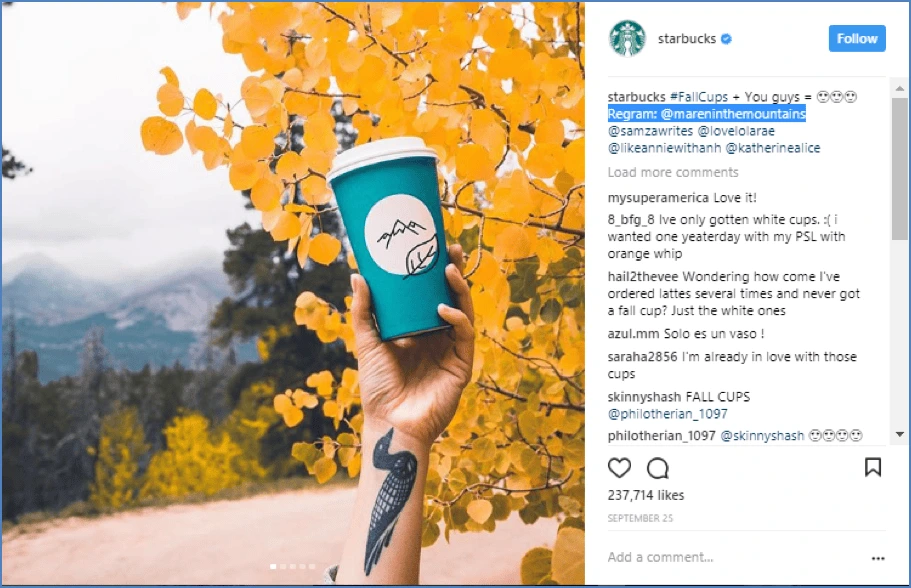
Source: Instagram
Starbucks constantly encourages followers to share their photos and, over time, has built a very active community of coffee lovers. They post their photos, and Starbucks shares the ones they like best.
As a result, the photo-taker gets attention and accolades, reinforcing the positive affinity they have for the brand. And Starbucks gets to spread beautiful pictures of their product that drive more engagement with their content.
You too can explore this option, starting by building a small community of users who love your product. Invite them to share pictures of themselves using your product, and watch how a win-win game can score points both for you and for your audience.
2. Just Eat—Hashtag your giveaways
Giving away freebies isn’t exactly a groundbreaker in business strategy, but there’s a better way to gain maximum impact. The food delivery app Just Eat nails this practice. It’s constantly running themed contests and food giveaways that ask users to tag their friends, send in entries, and generally join in the fun. As a result, for every item given away, Just Eat earns a great deal of traction and puts people in just the right mood for ordering food. #FindYourFlavor, #JustEatUK and #StrangerThings2 are just a few examples.
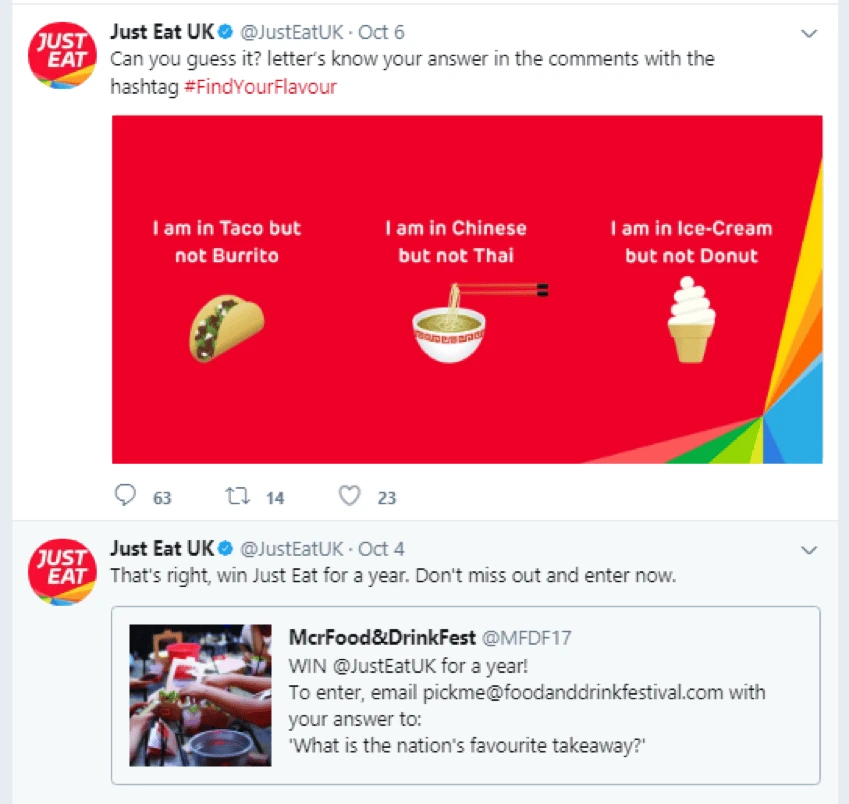
Source: Twitter
3. Lyft—Start a conversation
“While rival Uber is an efficient delivery service, Lyft is seeking to differentiate itself by offering a combination of ‘humanity and technology.”
Kira Wampler, Lyft CMO
Lyft crafts its social media strategy in that same vein by posting customer reviews, messages and conversations on their Twitter page. It aims to establish an identity as a warm, friendly taxi experience that nurtures relationships and cares about every single passenger. In fact, fantastic customer service has been Lyft’s calling card from the start, so playing it up on social media is a smart, brand-consistent move.
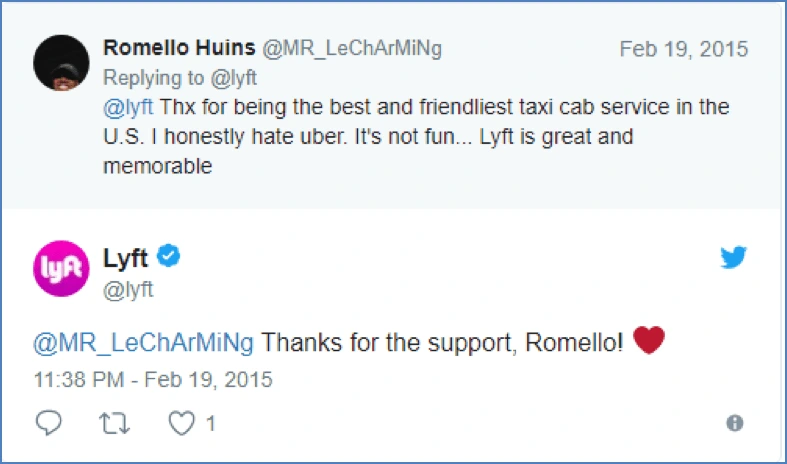
Source: Twitter
We all want to do business with brands that make us feel special. [![]() ] Forming personal relationships through conversation is basic human nature. You too can try exhibiting your warm, personal side by sharing users’ comments and conversations on your profile.
] Forming personal relationships through conversation is basic human nature. You too can try exhibiting your warm, personal side by sharing users’ comments and conversations on your profile.
4. Pokémon Go—Roll out teasers before major updates
Pokémon Go brought augmented reality gaming to the masses and attracted a huge fanbase in very little time. However, with shrinking attention spans, the initial excitement could’ve fizzled out quickly if they didn’t find ways to keep the buzz going.
Fans of Pokémon Go are treated to small doses of upcoming excitement through a regular cadence of trailers and teasers. The anticipation for new levels, more items, and higher scores is enough to make fans look forward to playing every update, making it one of the highest grossing games ever.
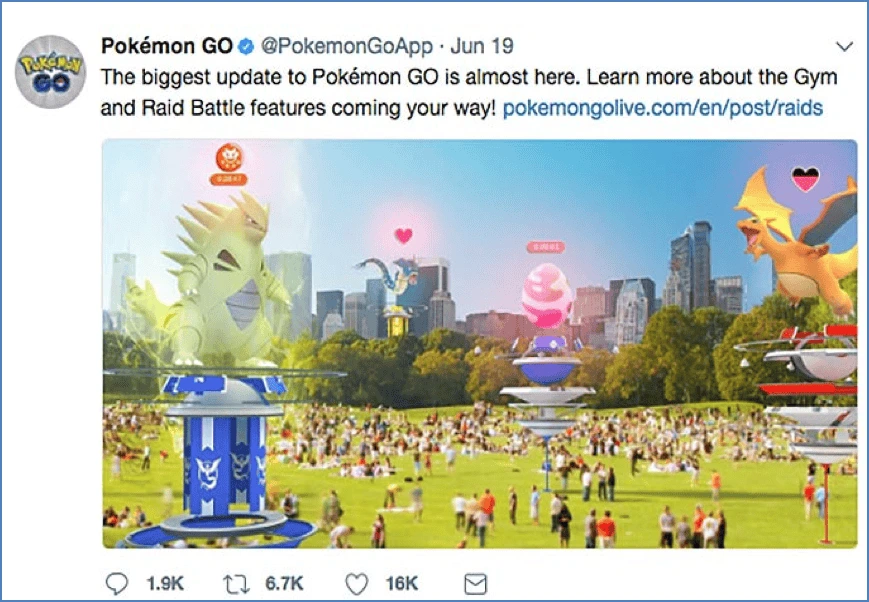
Source: Facebook
If you have a major update coming out, tease your followers with alluring clues, images and videos. This will keep the excitement alive until the update is finally out.
5. Angry Birds—Have a little fun with games
Angry Birds has been on social media since 2009, and from the start, their team has infused their brand’s personality with the fun of gaming. They are constantly running fun contests, posting fan artwork, giving away extra lives, and adding a light touch of humor to everything they post.
Plus, it’s not just your typical “share to win” giveaways. Contests come with clues and incentives to lure people into downloading the app. Riddles, puzzles, cryptic images and poems, it’s all there to keep users tuned in. Sometimes all it takes is a little fun and games to keep your audience engaged.
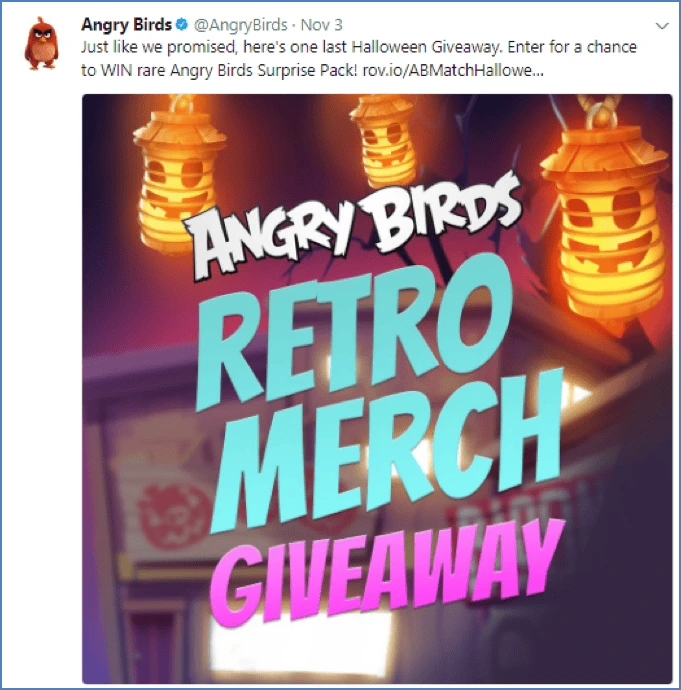
Source: Twitter
Wrapping up
Now you have 5 tried-and-tested strategies straight from the pros. These techniques can be adjusted and applied to nearly any brand willing to experiment with creative flair. The idea is to build connections and foster relationships with your users so you become part of their social lives. Try one (or more!) of the above tips and see how your audience responds—you might be surprised at your success.
Ready to drive more engagement and leads with social media? Grab a copy of our free eBook: How to adapt your brand to social media
Like every other industry, real estate has experienced rapid change due to new technologies. Perhaps the area that’s felt the most impact is marketing. It’s imperative to keep up with how it’s evolving to stay ahead.
Although direct advertising methods are still popular in real estate marketing, they’re not the only way to help consumers change their minds. That’s where influencer marketing comes in.
Related: How to boost your brand identity with influencer marketing
Word-of-mouth is no longer limited to meeting people in person; it’s expanded to include social media, too. Influencer marketing in real estate aims to draw in potential clients with content they’ll find engaging and valuable. Here are five influencer marketing strategies your brand can try.
Don’t underestimate the power of Facebook
Facebook offers ample opportunities for influencer marketers to connect with audiences organically. For example, you have personal pages, business pages & groups, all of which can provide multiple touchpoints.
There are various content options, such as photos, blog articles and videos, through which you can engage potential clients. Facebook posts that get the most likes are creative, genuine and have your brand’s personality written all over them.
In addition, Facebook is proven to be a brilliant tool to expand your database and sphere of influence. Personal interactions, even a simple birthday wish, are a great way to reconnect with clients and remind them you’re available.
Work with a combination of influencers
Many brands make the mistake of pairing up with the wrong influencers. Not every influencer will work for you, so it’s best to realize this early on. Influencers can usually be divided into three categories: mega-influencers (celebrities), macro-influencers (well-known), and micro-influencers (niche).
To determine which influencer would be right for you, you need to define your target audience. Are you looking to attract families and professionals? Perhaps millennials? People tend to follow influencers that represent the lifestyle they hope to achieve.
Many real estate brands choose a variety of influencers to maximize their reach on different platforms. The best influencer would be the one who’s most relevant to your campaign and can reach the most significant potential audience.
Be creative with video marketing
Video marketing, today, is a force to reckon with. Video marketing stats show 84% of consumers choose to buy something after watching a video and, by 2020, 82% of all consumer web traffic will be video. Compared to content that’s text-based, video has proven to be very effective and is perhaps the biggest trend for content marketing this year.
What does it mean for real estate brands? Well, it means more creativity. Audiences aren’t interested in the same old content anymore and are looking for something that’s authentic and hits home. Videos seem genuine, are fun, and add a degree of reality to the business.
A brilliant example of video marketing is Bedrock Real Estate’s “Anthem of Us” to encourage purchases in the Detroit area. The award-winning video starts off with a voiceover by rapper Big Sean (a native of Detroit) and highlights its culture and, most importantly, its people.
The video employs the use of a mega-influencer and multiple micro-influencers, a combination that hits the bullseye. Big Sean’s voiceover would be not worth sharing if it weren’t for the local people & businesses whose promotion led to the video going viral. The micro-influencers played a massive role in the campaign gaining ground locally, so if you’re aiming for a regional campaign, then local influencers might be more effective than international ones.
Related: Real estate video marketing — The ultimate content marketing tool
Build long-term relationships
With the growth of influencer marketing, the demand for influencers is at an all-time high. The number of brands getting in on the game has led to a rise in cost. In the past, brands could get away with free products as a form of compensation—not anymore.
Today, brands have to invest more time and effort in working with influencers. Once you’ve built a healthy relationship, you can ask them to promote your content. Perhaps the best way to get a referral is to make your influencer a client and have them share their own positive experience with their followers. There’s nothing more impactful than a genuine review.
Invest in Instagram
Last year, Instagram ranked as the best platform for influencer marketing campaigns. There are over 800 million users using the app every month, and that number is still rising.
Influencer marketing is likely to cross $2 billion by 2019, and Instagram is the best platform to use for brands and influencers alike. Its visual nature inspires you to get creative with your content and grab the attention of your target audience.
The best content on Instagram doesn’t just flaunt your product; it flaunts your personality. Don’t just post pictures of luxurious houses—post pictures of what makes it a home, too. How about a dog in the backyard? Or people enjoying food at the open house?
Influencer event marketing, in particular, is gaining momentum and is something you should start thinking about. Host an event and invite people with large followings to attend. The influencers are then responsible for creating engaging content that will drive awareness for your brand.
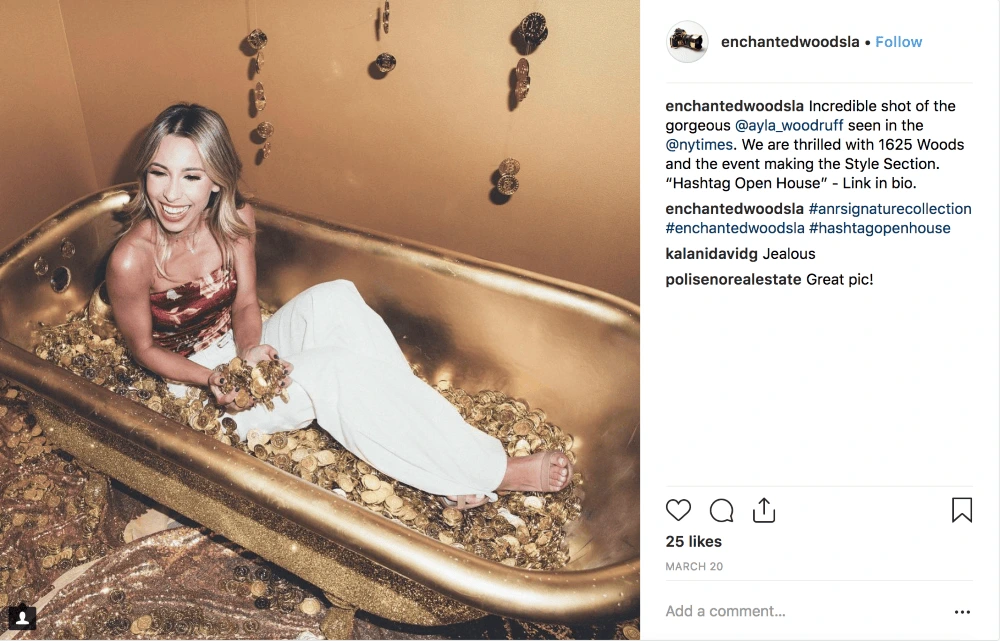
Source: Instagram
For instance, look at the photo above. Isn’t it gorgeous and fun? Would you believe me if I told you it’s from an open house in Los Angeles and the woman in the photo is an influencer?
The open house was set up in the most Instagram-worthy fashion and encouraged social media sharing. These real estate professionals understood the importance of making open houses seem less like what they are and more like a fun, eye-catching event that’s worth telling your friends about.
Key takeaway
Influencer marketing can boost your brand awareness efforts and be a valuable addition to your content marketing arsenal. The right influencer and the right platform are bound to set you on the road to success.
Before the rise of social media platforms, marketers relied on evergreen content. Evergreen content is content that’s always interesting, valuable or relevant to readers.
In contrast, ephemeral content is content that’s designed to last for only 24 hours. Snapchat, Instagram Stories and Facebook Live are all examples of places to post ephemeral content.
Related: How to use memes for social media marketing
The psychological concept of FOMO (the fear of missing out) makes ephemeral content great at increasing customer engagement.
Here, we’ll discuss how you can take advantage of FOMO to build your brand with ephemeral content.
Why should brands create ephemeral content?
When Snapchat came to smartphones, many people didn’t get it. What was the point in making a video or a photo that would disappear?
At that time, content creators focused on creating evergreen content to capture the interest of readers and stand the test of time.
Although evergreen content lasts, ephemeral content offers a sense of exclusivity. If you miss it, you miss it for good.
By making content ephemeral, you can keep your audience on its toes. They don’t want to miss out, so they pay attention. And on the internet, attention is king.
Large brands are already taking advantage of FOMO with their content. In 2016, an estimated 21% of BuzzFeed’s total traffic came from Snapchat views. As of 2018, Instagram Stories has an estimated 400 million users.
If you don’t get in on this trend soon, you’ll be the one who ends up with a bad case of FOMO.
How to use ephemeral content effectively
Ephemeral content offers unique ways to engage an audience. There are several different strategies you can use, depending on your preferred platform. Here are a few of them.
Reach out to your users and make them feel special
First, you have to reach out to your users. There are two good ways to do this: remarketing and influencer marketing.
If you’ve already established contact with your users, you can try remarketing. Use remarketing to announce new products, sales or discounts on products or services they’ve bought before to keep your audience engaged.
If you haven’t reached your audience yet, you can tap influencers to attend expos or invite-only events. Provide opportunities for them to take great pictures and try out your product. These influencers can then share their experiences with your brand via their social media accounts.
Keep in mind that not all fans have the clout or money to go to these events. Instead, you can give your regular users a “sneak peek” that not only makes them feel special, but also makes your brand feel real and authentic.
Be authentic and humanize your brand
Speaking of authenticity, one of the things that makes ephemeral content attractive is that it feels more real. However, to do this, you first have to know who you are and what you want to do as a brand.
According to Shopify, putting to paper the intangible facets of your brand (e.g. principles, philosophies, etc.) “should provide an ample introduction of why you’re in business, why you’re different, what you have going for you, and why you’re a good bet if you’re asking for an investment.” These will give you a guide for how to appear more authentic in your social media posts.
But, it’s not enough to know who you are and why. You also have to run your brand in line with your identity. When you have an identity and stick to it, it’s reflected in your content. Users like seeing employees at work behind the scenes—or real people using products in their own way. Take advantage of this and show users the unpolished side of your brand.
Keep your audience on its toes with live video
Live video is one way to show your audience that you’re authentic. But aside from that, it hooks them immediately.
When you use live video, your users are the seeing it at the same time as everyone else. According to Facebook, users spend up to three times more of their time watching live videos than non-live videos.
Here are a few ways to use live video:
- Show what goes on behind-the-scenes. You can show snippets of processes in your business, or company culture by showing staff in their element.
- Training videos. These videos are great for technical or creative brands. You don’t have to do full training sessions. Instead, you can treat users to related tips & tricks, Q&As or how-to guides.
- Contests or giveaways. These would not only reward loyal customers, but they can bring in new customers, too.
- Share live events. Not everyone has the chance to attend exclusive events. Live video lets you share memorable event moments with all your users.
Facebook Live is a popular platform for live video streaming. If you plan on using Facebook for your live videos, make sure you know when the best times are to go live so you can get the most engagement.
Get your users involved with a call-to-action
In the end, you want your users to do something. That’s why you include a call-to-action.
With ephemeral content, the call-to-action is usually a link to a landing page. Because ephemeral content doesn’t last forever, you need to make your CTA clear and concise.
Make sure you tell your audience exactly what you want them to do. “Click this link!” and “Swipe up!” are good examples of clear calls-to-action.
Best platforms for ephemeral content
Now that you have an idea of how to maximize ephemeral content, it’s time to decide which platform to use. Each platform has its own features and user base. Here’s a short breakdown of three popular platforms.
Snapchat
Snapchat is popular with younger users, so you should consider Snapchat if they’re your target market. Snapchat uses Snapcodes, which are QR codes users can scan to follow brand profiles. Snapchat also has geo-filters, which can be used for time- and location-sensitive events or promotions.
Facebook has a huge user base that’s varied in demographics. If you plan on integrating ephemeral content with a brand page, Facebook is the way to go. Facebook Stories gives users a way to enjoy ephemeral content without clogging up their newsfeed. It also allows you to supplement your ephemeral content with posts on your main page.
Instagram has a huge user base. In 2017, Instagram Stories had more than 200 million daily active users, a number that’s doubled since then. If your brand is visual in its marketing style, Instagram is worth a look. You’ll be able to supplement your photo feed with Stories. Instagram also allows in-story links, making calls-to-action easier for users to follow.
Key takeaway
Ephemeral content is a trend that isn’t going away soon, even though these posts only last for 24 hours.
If you’re looking for a new way to engage your users and keep them interested, ephemeral content is something you should think about. Are you already using ephemeral content? How is it working for your brand? Show us your favorite examples on Twitter by mentioning @lucidpress.
Why talk about sustainability?
You’re probably fed up with the terms “millennial” and “Generation Y,” but they’re still helpful when describing that particular group of consumers.
For example, one trend that keeps popping up is their desire to buy from brands brave enough to set standards of behavior and live by a set of principles.
Related: 5 content tactics to ignite brand engagement with millennials
I’m a millennial, and for the first time this year, I was able to go to my local zero-waste store and buy travel toiletries for my summer vacation. I even paid a lot more for the privilege and left the store with a fuzzy feeling and a huge smile. Does this sound unusual? Trust me—I’m not the only one in my peer group who looks for opportunities like this.
If you’re looking for more reasons to build your brand around sustainability—and examples of brands that are doing just that—read on.
Boosting that bottom line
If you want to show the market that your company is in it for the long haul, having a sustainability strategy is a case of when, not if.
We know that 75% of millennials millennials say sustainability is a shopping priority, more than any other group. [![]() ] Yes, we came of age during the Great Recession and aren’t the richest generation (hello Boomers), but we are getting wealthier. And, importantly, we are willing to pay more for things that matter.
] Yes, we came of age during the Great Recession and aren’t the richest generation (hello Boomers), but we are getting wealthier. And, importantly, we are willing to pay more for things that matter.
The problem with sustainable business practices is the misconception that being good equals less revenue.
Even Forbes agrees that you can earn better returns from investing in good companies. If you’re not positioning your company to look after the planet and its people, you’re already behind. The time is now.
Leading from the front
Do you want your brand to be on the cutting edge, forming relationships with international audiences? Or do you want to be trying to figure out why your quirky social media campaigns aren’t getting the engagement they used to?
The United Nations are fully focused on achieving their Sustainable Development Goals by 2030, and your brand can be part of that through the work of the Global Compact division.
Of course, this is step one in the process. Your brand won’t survive on goodwill alone. It has to produce a steady profit to grow and spread your positive message further.
Step two is telling your story, integrating sustainability into your brand and making sure the entire company is on board and proud of the work you’re all doing.
Telling your “triple bottom line” story
If you’re not familiar with the triple bottom line, it’s the idea that your business should be measuring and reporting not just a financial bottom line, but social and environmental bottom lines, too.
This is how you truly integrate your business with sustainability. There are several ways to get started on this, but some useful resources are:
- B-Corporation. This is a framework any business can pick up and follow. It guides you on best practices for triple-bottom-line business plans, and you get a certification at the end.
- Global Reporting Initiative. The GRI is the go-to resource for sustainability reporting. Using GRI, you can easily figure out what you can report and how to report it.
- Integrated Reporting Council. Integrated reports are becoming increasingly necessary, bringing together financial and non-financial data in one place. It helps your stakeholders get a fuller picture of your company’s performance.
You can use these frameworks that are already created and layer them throughout your business. It’s a time-consuming process to get all of the data in place, but once you have it set up, it’s well-worth the effort.
What’s important to you?
The next part is understanding which issues are important to you and your audience. For smaller brands, your audience will include customers, employees and management teams. For bigger brands, that list might also include governments, local residents and other organizations.
A great place to start with your sustainability efforts is to pick an issue that you all feel strongly about. This will get everyone excited to transition, and while we all know that change can be difficult, successfully launching one project makes it easier to do more.
If you’re thinking of starting a business or just launched one recently, this can still apply to you. Think about your processes as you build them, and ask the question: “Can I repeat this action for the next five years and feel good about it?” If the answer is no, then you have an opportunity to future-proof.
Now that you have an amazing project going on—whether you’re off-setting your carbon output, adding mental health support to your team’s healthcare packages, or engaging your local community in a social development project—it’s time to tell the world.
Using social media
We’re past the point of debating whether social media is relevant. It is. It’s also a fantastic place to tell your brand story in an authentic and engaging way.
The number-one rule here is not to just throw out a few posts about sustainability and expect them to get the engagement they should. Create a new marketing plan with your project at the heart of it, and find ways to tie more of your posts back to sustainability.
The power of Instagram and live-streaming
For Instagram, consider using longer captions. If you have a good reason for a long post, then don’t be afraid. Yes, social media is often about standing out, but that in itself is not a sustainable business practice. If you’re just using pictures of puppies because research shows that puppies get the most likes, then you’ve missed the point of marketing.
Make your social media pages (especially Instagram) reflect your authentic self. Check out @ErinOutdoors or @SophieHellyer, who’ve both attracted loyal communities with their authenticity. Let it showcase the values of your brand so you can attract an audience who cares about those same things.
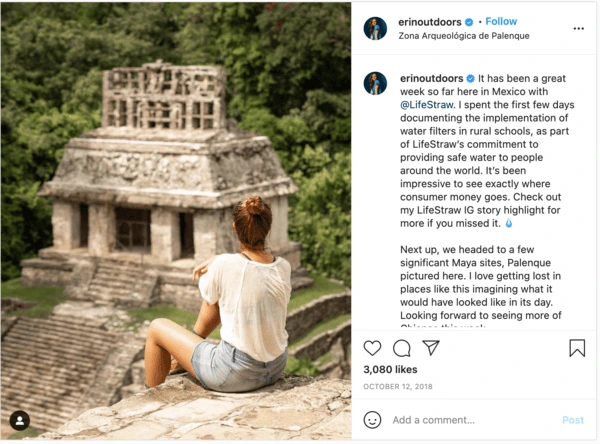
A post shared by Erin Sullivan (@erinoutdoors) on Oct 12, 2018 at 8:00pm PDT
If you have someone who’s particularly good on camera, give them a platform to talk about your project in a live stream. Most social platforms now have a solid live-streaming option. Take advantage and give your audience access to backstage conversations about your brand. Be brave and be there for your community.
Building a community
Having worked in marketing for a long time now, the most common thing I see is a fear to stand up for something important because it might upset some of your customers. You could sell anything to anyone, but that’s not building a brand legacy—that’s trying to make a quick buck.
If you consider community-building to be part of your marketing strategy, then you need to have a positive message. Brands that build positive messaging in their content and communication are the ones that stand out against the negative cycle of mainstream news.
Examples of great sustainable storytelling
There’s nothing like seeing examples that work, so we’ve curated a few samples of brands we absolutely love.
TRIBE — Sports nutrition with a conscience
At Conscious Creatives, we try to encourage physical activity as part of a healthy lifestyle, getting our team healthy through running, cycling, surfing and more. One of our biggest forms of inspiration in this respect is Tribe—a brand dedicated to making sports nutrition products with natural ingredients.
What we love about Tribe is that their marketing plans are based on creating a community. They’re a collection of people who love being outdoors, brought together by sporting events all over the world and a combined effort to rid the world of human trafficking.
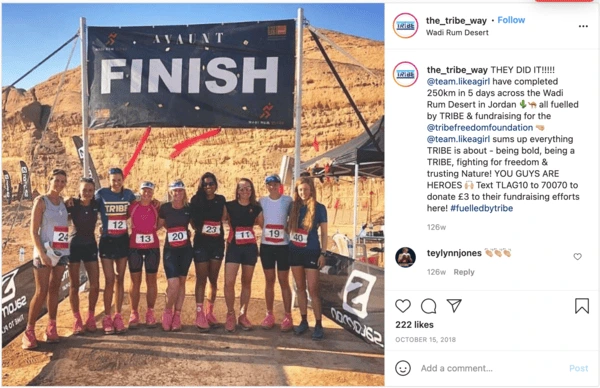
A post shared by TRIBE (@the_tribe_way) on Oct 15, 2018 at 12:46pm PDT
Tribe is a community of nutrition experts who care about the world. It just so happens that they also sell nutrition products.
Lewis Pugh — Swimming to save the seas
An example of someone who definitely fits the definition of inspirational is Lewis Pugh: swimmer, speaker and general mind-boggling human being.
He’s just completed The Long Swim, a 560-kilometer effort spanning the length of the English Channel.
Why would a person attempt such a thing? To raise awareness of the sorry state of our oceans. Lewis’s feat is the start of a worldwide campaign that aims to fully protect 30% of our oceans by 2030.
A real-life hero and conservationist, Lewis defies all logic and pushes himself to the limits to earn media coverage of the cause. See this photo of his encounter with a plastic bag during his long swim. He used a powerful image, a long caption and specific instructions to make our oceans cleaner.
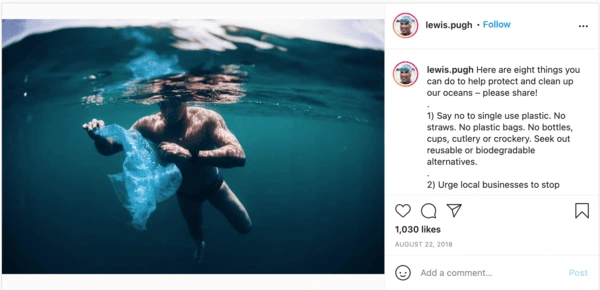
A post shared by Lewis Pugh (@lewis.pugh) on Aug 22, 2018 at 7:19am PDT
That is how sustainable marketing will change the world.
rCUP — Recycling reusable cups
I am proud to share a hometown with these folks. They discovered that only 0.4% of recyclable coffee cups were actually being recycled. So, they set about designing a product made from precisely those cups.
The rCUP is a reusable coffee cup that is affordable, looks great and has some wonderful little design elements that make it really easy to use.
A post shared by rCUP (@rcuponeplanet) on Jul 21, 2018 at 11:32am PDT
Sustainable marketing is so much easier when you’ve got products that make a real difference.
How to get started
If you’re reading this and are equal parts excited and confused, you are not alone. I suggest finding a community of like-minded business folks who are also looking to make more money by doing the right thing.
LinkedIn is a great resource for finding sustainability professionals, and our community is strong in voice. We’re all so proud of the work our peers are doing and the causes that we stand for.
Look into your industry to see which organizations support sustainability. You’ll be surprised to discover wonderful groups ready and willing to help, no matter what stage you’re at. For example, if you work in fashion, the Ethical Fashion Initiative is a wonderful example.
The key, though, is to start.
Don’t be afraid to try. Know you aren’t going to do it perfectly, but also know that simply trying is a great thing. Watch as your community grows and rallies around your brand for years to come.
Today, over half of the world (4.89 billion people) use social media. A pretty staggering number, right? What’s more, a typical social media user spends an average of 151 minutes per day scrolling through their feeds. Given all of this, it’s easy to understand why most brands are active on social media today. There’s a huge opportunity to grow your brand awareness here, especially if you follow the right strategy.
So how can you cut through the noise and make sure your brand stands out to the right audience? Let’s go over a few tips that will help you get the most brand awareness out of our social media efforts.
Choosing the right platforms
Right now, there are over 120 social media platforms out there. Thankfully, your brand doesn’t need to be on all of them to have an impact. Remember the phrase, “more isn’t always better”? That’s a good mantra to keep in mind when you’re choosing the platforms you want to be active on.
With so many options, it’s okay to be picky here. To help you get started, consider the strengths and weaknesses of each platform, along with the demographics of its user base and how easy (or difficult) it will be to get your content in their feeds.
Of course, just because one platform is popular doesn’t mean it will necessarily be a good fit for your brand. For instance, if you’re an HR consulting firm targeting c-suite teams, your content might be more suited to LinkedIn than TikTok – despite it being the fastest growing platform out there right now.
One last note here: While we think it’s important to be somewhat picky here, try not to put all of your social media eggs into one basket. As platforms grow and change, they may no longer be suitable for your brand. For example, you don’t have to look very far to see plenty of brands that either paused advertising or left X a.k.a Twitter entirely after controversial changes to the app and its leadership.
Creating a brand persona
Brand recognition = brand awareness. There’s nothing that builds brand recognition faster than a unique, memorable brand persona. Think of this as the voice and POV of your brand. What – or who – does your brand sound like?
Nailing your brand’s personality is one of the most important parts of building a rock solid social media strategy. Knowing your target audience inside and out can help – after all, it’s much easier to develop a brand persona that will resonate if you know the kind of people you’re looking to reach.
But what if you have multiple audiences? No need to fret. You’ll just want to develop a more flexible brand voice that can speak to your different audience segments. For example, you may showcase more of your brand’s fun, humorous side on TikTok, while your LinkedIn presence may be more focused on product updates, internal news, and informative content.
Publishing authentic, consistent content
If you want to thrive in today’s over-saturated market, your brand needs to be consistently producing high-quality, engaging content.
You can start by focusing on topics closely related to your particular niche. For example, if you own a plant shop, you can share information on various plant species, as well as helpful tips and tricks on how to take care of them.
Pre-measured templates are an easy way to start building on-brand content at scale. At Marq, we’ve got a library full of social media templates to get you started.
Lastly, a note on consistency. You can post the most amazing content, but if you’re only posting a few times a year, you’re not going to be able to build the kind of brand awareness that a more active account can. If you’re irregular or inconsistent with your social media branding efforts, your audience might forget about you. (Plus, your absence and lack of posts might even make them think you’ve forgotten about them, too!)
If you can’t post consistently on a regular basis, try using scheduling tools. Schedule your posts at peak times when your followers are most active. This will give your content the best chance to gain visibility and momentum.
Building brand awareness through audience engagement
If you look at successful brands on social media, the vast majority of them interact regularly with their audience. They start conversations, ask questions, and interact with their fans in many of the same ways you might interact with a friend.
Intentionally engaging with your audience can have an incredible impact – not only driving brand awareness but helping people build an emotional connection with your brand.
Here are just a few methods for drumming up engagement on your socials:
- Host giveaways or promotions with branded hashtags
- Sprinkle in user generated content into your social calendar – and encourage your followers to tag you in their own photos for a chance to be featured
- Partner with local or micro-influencers to build a sense of community around your brand
- Respond to audience comments, questions, and concerns to create trust
Key takeaway
It’s not enough to simply have a social media presence anymore. Any brand can publish content, but those that truly go above and beyond have the chance to cultivate a level of brand awareness that rivals the world’s leading companies.
Want to streamline your social media content creation? Check out our template library and start designing on-brand today!
Attracting a steady stream of new customers is one thing, but building customer loyalty is integral to a brand’s long-term success. And it begins with making a good first impression.
Think about it: when looking up a brand online, what do you remember about the ones that stand out? More than likely, it’s their logo or their overall style—like meeting a person wearing a great suit. When you run across that brand again, that image can stick with you—more so if you keep on seeing it in different places. This is a brand’s visual identity, and it’s what you want potential customers to remember.
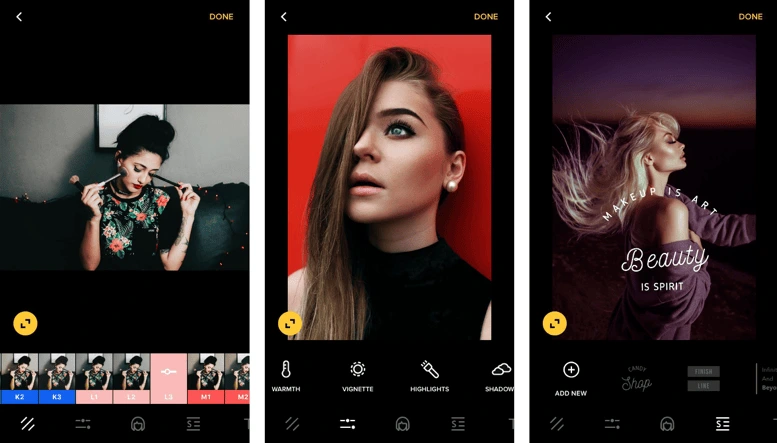
Related: 6 Instagram post ideas to boost sales
Having a memorable visual identity is important for social media, now a standard tool in the digital marketer’s arsenal. Instagram in particular is a powerhouse for using visual content to promote products and services, with Instagram stats showing 71% of U.S. businesses have an Instagram profile (25 million business profiles total). Standing out and earning engagement and followers depends on how well-defined your visual identity is. Here’s how to do it.
1. Know your brand inside and out
Before you create a visual identity, you need an actual identity first. Know the key aspects of your brand you want to communicate to your audience, then translate them into a visual medium. [![]() ]
]
Essentials for this step are copies (in writing!) of your brand’s mission, vision and values. These should be easily accessible on both your official website and any internal marketing documents. When you have them, answer the following questions to figure out what you’ll need to base your visuals on.
- Why was my brand made?
- What does my brand value the most?
- What words would I use to describe my brand?
- What does my brand offer in terms of products, service and experience that others do not?
- What kind of people do I want my customers to be?
Using your answers to the questions above, you can isolate a set of keywords closely associated with your brand.
2. Create a set of branding guidelines for social media
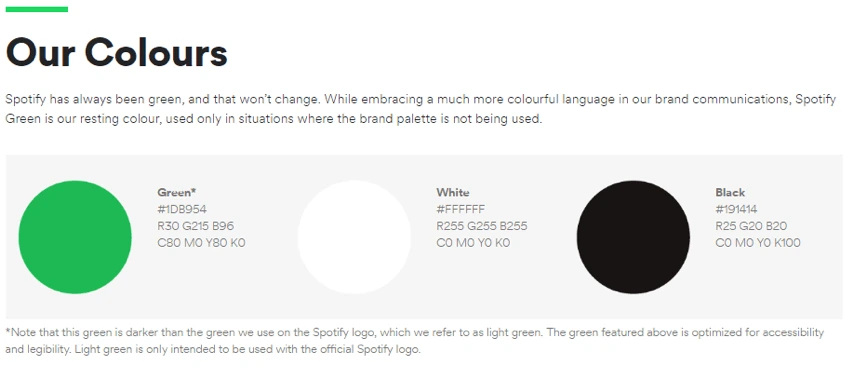
Source: Spotify
Do not underestimate the logistical power of good documentation. Brand guidelines enforce consistency in your branding, graphic design and marketing—keeping everything together so that everyone is on the same page when it comes to how to visually present your brand.
While it does take time and effort to create, having all these details in one place saves more time in the long run. It’s also a mark of professionalism: no having to go back and forth, emailing each other files and instructions every time you design something new.
Looking at some great branding examples, here’s what to include in your brand guidelines:
- The theme of your brand
- The feel and philosophy of your company
- Relevant taglines
- Font styles & typefaces to use
- Acceptable ways to use your brand logo, including its size & placement
- Color palette to use when associating with the brand
- Guidelines on composing imagery
3. Make social media post templates
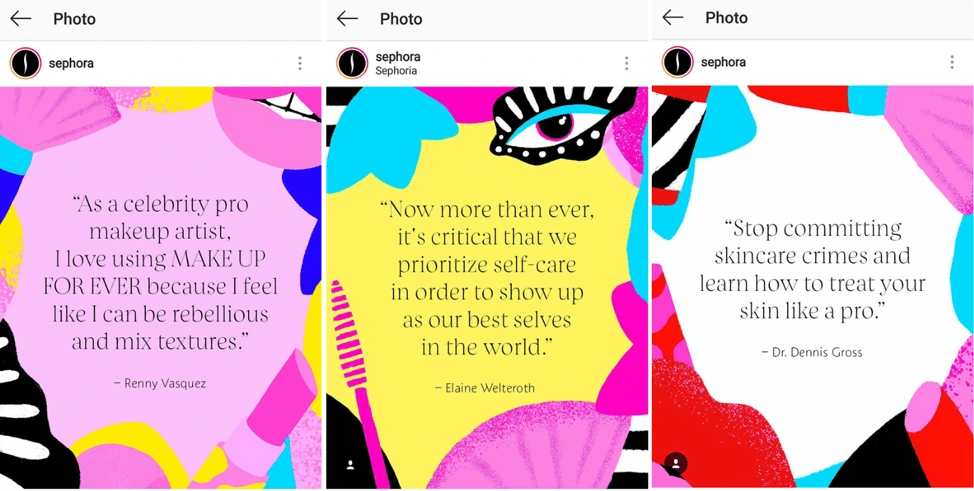
Source: Sephora
If you want to be remembered for a certain color or type of imagery, or if you want your logo to be visible on the feed and not just in your profile photo, turn to Instagram post templates. Some examples are backgrounds for text posts or borders to place around photos. They might include your logo, brand name or slogan and should be used when appropriate—not all the time, but just enough to be noticed.
You can use these templates when you share some of your favorite quotes to Instagram, which can make an otherwise plain text post look interesting. You can also place template borders on user-generated content that you’d like to share on your profile—especially useful if you’re running an Instagram giveaway or photo contest using a particular hashtag that can be incorporated into the template.
Remember to mix it up once in a while as well. While you want it to be memorable through retention, you don’t want it becoming stale. Try mixing it up every month or two and changing it according to season or campaign.
4. Have a consistent photo-editing style
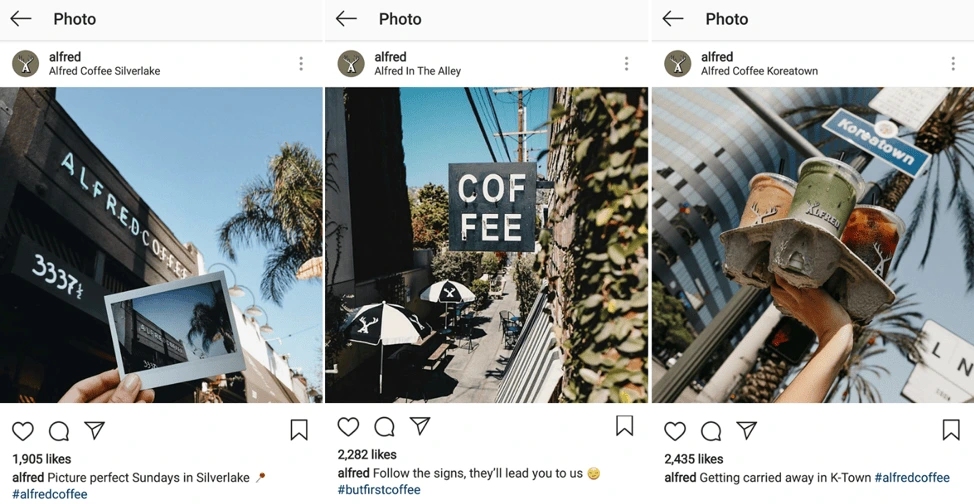
Source: Alfred
Once you’ve identified the feel of your brand and the colors you associate it with, fold that into the way you edit photos. Color has long been known to be a powerful force in marketing, and by post-processing images before you post them online, you can influence what they convey.
Use a similar editing style with your pictures so they all communicate your message—and slowly, users will connect that feeling to your brand. Away from your computer and need something quick? For extensive editing on the go, download a reliable photo application like Instasize to your mobile phone.
5. Do social media right
Last but definitely not least, make the effort to use Instagram right.
What does this mean? No matter the amount of content you share, and no matter how elaborate your photo editing is for each image, your efforts won’t matter if you don’t make use of the rest of the platform. Instagram has boomed—and so has its features.
One of the biggest don’ts of Instagram right now is to post strictly to the feed only. Instagram also has Stories and IGTV, the former of which can be an informal way to connect with your customers, while the latter gives space for long-form videos that followers would otherwise miss.
Of course, don’t let all your efforts towards keeping your visual identity end with social media. After all, using Instagram is just one step in the marketing funnel. Creative consistency builds trust, showcases reliability and improves customer perception—especially in visual branding. Keep your branding consistent across touchpoints before, during and after purchase, and you’ll be crafting a brand story customers won’t forget any time soon.
Want to know more about the power of brand consistency? Download our free 32-page report, chock full of stats & great insights.
Social media has changed a lot over the last decade—and the way marketers manage social media channels has changed, too. Few marketers have the bandwidth to stay on social media all day, curating and sharing content as they go. Many of us have additional job responsibilities, and we have to be structured and deliberate about the time we dedicate to social.
Related: 6 effective social media strategies to increase brand awareness
Fortunately for us, there are lots of tools out there designed to make social media management easier and more efficient. From finding sharable content to scheduling posts, the 30 tools listed below can help you streamline and automate the tasks you can—so you have more time to spend on the ones you can’t.
What is social media automation?
Before jumping into the list and trying out the tools, let’s quickly clarify what we mean by automation. Social media automation is using software or tools to accomplish specific tasks on social media platforms without human intervention. Put simply, it means using a program to automate things like posting and sharing content on Facebook, Twitter, and other platforms.
30 best social media automation tools
Without further ado, let’s get to our list. You’ll find big players and small players here, with a variety of specialties and capabilities, so there’s something for everyone. The descriptions are short, just to give you a general idea of each tool’s primary strengths. If you want more info, give one a click and check out their website.
Our picks for the 30 best social media automation tools out there today are…
1. Buffer
One of the market leaders, this popular tool lets you schedule & publish upcoming posts across all of your social media accounts. It also offers excellent analytics on your campaigns.
2. Hootsuite
Hootsuite is another popular choice. You can use it to schedule your posts and monitor the competition. Using search streams, you can more easily build a community of followers.
3. Workflow
With Workflow, you can craft the ideal workflows (hence the name) so that the right content is always shared at the right time.
4. SocialPilot
The tool automates the process of scheduling content across various social media accounts. You can also learn more about your followers, so you can determine the right content to post.
5. IFTTT
An acronym that stands for “If this, then that,” this free tool lets you set up rules for how different tools, apps and social media platforms trigger one another. It’s a simple concept that’s hard to explain, so pop over to their website for details and examples.
6. Sendible
The tool is designed to help you schedule updates, reply to followers, create reports, and collaborate with others.
7. Later
Later is a powerful tool for Instagram scheduling that boasts over 600k customers. Unlike many social media tools, you can use this one to manage comments.
8. Tailwind
Tailwind is an automated scheduling and analytics tool that’s great for Pinterest. It will recommend the best times for you to post to reach your audience.
9. CoSchedule
This application helps you to schedule all your posts. In fact, you can schedule over 60 posts at once! You can also use it to lay out your social media calendar.
10. Post Planner
This simple tool helps you to find content and schedule posts for your social media accounts.
11. Iconosquare
Iconosquare arms you with personalized information about your social media accounts that will help you manage activities more efficiently.
12. Agorapulse
You can easily plan and schedule posts across your social networks with this tool, but it’s also useful for tracking performance.
13. Crowdfire
This automation tool helps you root out inactive Twitter followers. It’s also worth using if you want to discover the right cadence and content to share with your audience.
14. Socialert
Social media listening is made much easier when you use this tool. Again, it’s all about finding the best content for your audience and being part of conversations as they happen.
15. BuzzSumo
BuzzSumo is popular with content marketers because it’s great at finding trending topics. Results can be filtered based on location and domain. You can also find influencers here and start building relationships with them.
16. Scoop.it
With this tool, you can easily curate content from other sources and share in a way that reflects your brand’s personality and values. You can also use it to set up a smart social calendar.
17. Pocket
This “read later” tool lets you save content you find around the internet. The service is free, and you can access it anywhere, so you’ll never lose track of that one awesome article you found again.
18. Sprout Social
Designed to help small businesses use social media more effectively, this tool automates posting. It can also help you engage with an audience and monitor the competition.
19. Mention
You’ll never miss a conversation your brand is mentioned in when you use this tool. It’s also great for identifying influencers and monitoring keywords in real time.
20. TweetDeck
TweetDeck is an awesome free service for social media listening on Twitter. You can set up custom timelines to track brand names, usernames, hashtags, keywords and more.
21. SocialOomph
SocialOomph makes it really easy to manage your Twitter accounts. Effortlessly schedule tweets, track keywords, and more.
22. MeetEdgar
MeetEdgar is a fascinating take on social media automation. You can build a library of content you’d like to share across different platforms, and Meet Edgar will automatically schedule it for you—including repeat posts. It can even write variations of your posts to keep things fresh.
23. Everypost
Everypost is perfect for brands who want to schedule and share visual content on social media.
24. Facebook Pages Manager
No surprise here, this app helps you manage your Facebook pages effectively. You can get insights on traffic, clicks and views from its main menu.
25. Zoho Social
With Zoho Social, you can schedule as many posts as you like and monitor keywords & trends. It’s great for teams who collaborate on social media.
26. SocialFlow
This is one of the best tools for publishers, because it replaces arbitrary scheduling with data-driven scheduling, so your audience is engaging with you in real time.
27. Social Studio
Social Studio by Salesforce offers marketers a range of features such as publishing posts across various platforms, social media listening, and managing marketing commands.
28. Sprinklr
This tool helps you to achieve end-to-end social media marketing management. Data is unified across platforms, and publishing is automated.
29. DrumUp
DrumUp is an interesting tool that helps you discover and share meaningful content with your audience.
30. Kontentino
The last tool on our list provides you with easy, flexible workflow management. Content is easy to schedule, share and modify.
Bonus: Lucidpress
That’s right—it’s yours truly! If you’ve used Lucidpress before, you might be asking yourself: Why are we including ourselves in this list?
The answer: because Lucidpress has a host of new features that actually make it easier than ever to streamline social media for brands.
Everyone knows we offer some of the best free social media templates around—but have you ever considered creating your own branded templates with certain elements locked down?
Imagine if, instead of starting with a blank slate, you could always start with a perfectly sized template that uses your brand’s colors, fonts & logos. That would save a lot of time, right?
Don’t forget, you can share your Lucidpress designs straight to Facebook, Twitter and Buffer… without ever leaving the tool. That makes it a one-stop shop for creating beautifully branded social media posts and sharing them to your platforms of choice.
Key takeaway
Social media automation helps you discover and share the right content at the right time. Automation tools can also help you analyze audience behavior, monitor conversations, keep an eye on competitors, and more. For the best results, consider your business’s goals with social media (and your preferred budget) before selecting a tool.
Ready to drive more leads and engagement with social media? Grab a copy of our free ebook: How to adapt your brand to social media
Social media can help real estate agents find a wide audience, in the right area and at the right time.
In fact, according to the National Association of REALTORS 77% of real estate agents use social media. Facebook is by far the most popular platform in real estate, followed by LinkedIn and Instagram.
Related: Real estate marketing guide
Even with limited resources, savvy real estate agents can build meaningful relationships and earn more clients with social media.
How do you do it?
The sheer array of social media platforms and real estate marketing techniques seem overwhelming. Here are seven and a half practical tips to get you started in no time.
Social media for real estate tip #1: The basics
If you are already set up on social media, go ahead and skip ahead to the advanced tips below.
Facebook for real estate
To get started, set up a business page on Facebook. This is more professional than posting to a personal account and gives you access to useful business features such as page analytics and the ability to promote posts to your audience. Posts with images and video perform best on Facebook, so be sure to use compelling visuals with every post you create.
The Facebook algorithm favors posts that get a lot of engagement, so ask questions to drive comments or share content your followers will enjoy such as an upcoming local event, so they like and share it. If you’re just getting started and don’t have a large social media following yet, holding a contest to bring awareness of your real estate page is a great way to build up your follower count.
Instagram for real estate
Instagram is quickly becoming one of the most popular social media sites. As a visual platform, every post will need to be visually compelling. Use the caption that goes with the photo to provide additional details and include your contact information. A single Instagram post can be made up of a series of images, making it a great way to show photos of a new real estate listing.
LinkedIn for real estate
Update your personal profile and if you are running your own business, create a page for the business as well. LinkedIn provides a great opportunity to network with other real estate agents, connect with real estate brokerages and connect with current clients.
Social media for real estate tip #2: Start two-way conversations
A staggering 94% of millennial homebuyers are taking their search online. This creates incredible opportunities for real estate agents to connect with them there—but only if they truly understand their audience’s motivations.
It’s tempting for real estate agents to promote their business and new home listings relentlessly on social media. After all, isn’t that what those platforms are for?
Not exactly. For potential homebuyers, constant, in-your-face promotion has minimal appeal. If they wanted endless advertisements, they could just flip open a magazine or turn on the TV. Treating them this way shows a fundamental lack of understanding about your target audience.
The vast majority of potential homebuyers are searching for information. They have questions. If they’re considering buying for the first time, they’re probably intimidated, too.
Savvy real estate agents use social media to walk everyone through the process, creating stronger bonds than the constant sales pitch approach. Instead of just posting endless promotional content (a one-way broadcast), you open up two-way conversations. The audience becomes a key creator of the shared experience.
This takes on many forms. It might be searching Twitter hashtags and offering real estate advice to those in your local area. Tomorrow it might be hosting a Q&A session on Facebook Live. Next week it might be something as simple as asking a question in your newest listing photo caption on Instagram. Whenever you can, invite your audience to participate in the conversation.
Yes, you can still find opportunities to promote your real estate listings. But, a commitment to being relentlessly helpful builds trust and authentic relationships.
Social media for real estate tip #3: Choose your social media platforms wisely
Social media is fast-paced, chaotic, and changing constantly. It’s easy to get overwhelmed by the sheer number of platforms.
Real state agents new to social media might feel the pressure to “be everywhere.” Pressed for time already, they drive themselves crazy trying to maintain a presence on a dozen different accounts.
This approach actually leaves them worse off than before. Because they’ve spread themselves so thin, it’s impossible to get the traction needed to build an audience on any platform.
What could you do instead?
Start by taking a deep breath. Acknowledge there are tons of platforms out there—and a lot to learn. And accept that you’ll see the best results for your real estate business by focusing on just a few right now. Begin the journey with proven social networks like Facebook, Twitter and Instagram.
Which platforms deserve the majority of your focus? A lot depends on your audience. Beyond the overall popularity of the platform, consider where your target market spends their time online. You wouldn’t want to launch a Snapchat strategy when trying to sell retirement condos—the demographics there skew too young. If you’re selling commercial real estate, consider connecting with successful professionals and industry organizations on LinkedIn.
Do some preliminary research to pinpoint where your audience is most engaged. Other real estate agent’s and brokerages accounts can be a great place to start. Using those insights as a guide, narrow your focus to a few platforms as availability allows… which brings us to the next point.
Social media for real estate tip #4: Post consistently (and strategically)
A successful social media for real estate strategy is a lot like a successful relationship-building strategy in real life. You need consistent contact—and interactions that provide value and motivate people to keep coming back.
The goal: create enough interactions for your audience to get to know you as a real estate agent without overwhelming them to the point they tune you out.
This is a delicate balance to maintain, but the good news is it’s something you can always adjust as you go. Feedback from your networks (whether you’re gaining or losing followers, their engagement, etc.) will tell you if you’re headed in the right direction.
You can use social media software to schedule posts beforehand. This gives you the freedom to meet with clients, work open houses, and attend closings all while building your presence automatically. It’s easy to post multiple times a day this way.
Posting frequency is one thing, but you also have to consider the nature of the content itself. Most content breaks down into three different types:
- Time-sensitive/promotional. These posts advertise new properties on the market, open houses, or your brand in general. Think of listing photos, tweets urging prospects to give you a call, and virtual tours with Facebook livestreams or 360-degree photos.
- “Evergreen” how-to or informative. This content answers questions, shares tips, or finds alternative ways to provide value. It’s just as valuable a year from now as it is today. This could be decorating tips, a checklist to help you see how much house buyers could afford, or cool DIY renovation project ideas.
- Fun or entertaining. This content might not be directly related to real estate, but it’s a great way for you to showcase your personality. It might be a review of a new restaurant in town, a heads-up about traffic on the way home, or even those viral cat photos. Social media just gets prospects in the door. It’s your personality and expertise—real-life relationship skills—that will close the deal.
Understand the goal of each post you make, and mix things up to engage your audience and keep them coming back.
Finally, remember that there’s no need to create all this content yourself. Supplement your own efforts by sharing, retweeting or linking to other great content in the real estate industry. Your clients are a great content source—whether it’s sharing a quote from their testimonial or a photo of them toasting a new home.
Social media for real estate tip #5: Incorporate storytelling
Every great real estate agent knows how to tell a compelling story. Include that storytelling element in the social media content you create.
Some examples:
Talk about the neighborhood. When posting a new real estate listing, do more than talk about the price and features of the home. Create a compelling story by including details about the neighborhood. Help the potential buyer picture what it would be like to actually live in that home.
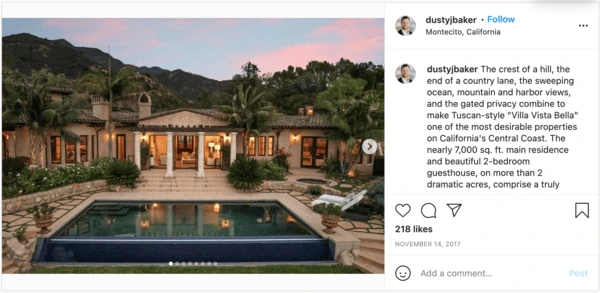
A post shared by Dusty Baker (@dustyjbaker) on Nov 14, 2017 at 10:46am PST
Include client testimonials. Ask happy customers if they’d be willing to create a video testimonial. Testimonials make compelling stories that help build trust with your audience.
Share milestones. On LinkedIn, share milestones of your real estate business. This could be anything from 10 years in business to updated branding or a new website.
Using storytelling in your social media campaigns will help drive greater engagement and build trust with your audience.
Social media for real estate tip #6: Use great, on-brand visuals
Social media has transformed the way realtors and agencies connect with potential buyers and clients. Because of the visual nature of house shopping, it’s easier than ever for people to go online and find examples of their dream homes.
Ideally, this should make real estate marketing faster and easier… but unfortunately, that’s not always the case. If you’re unfamiliar with Photoshop or other desktop publishing software, it can be difficult and time-consuming to create content specially for each social media site.
Instagram is a completely visual platform, which makes it perfect for marketing real estate. Photos are nice to have, but it can leave buyers confused as to what to do next—”Is this property for sale or just for show?” they might be wondering. By using this square photo collage, you can show off multiple views of the property and guide folks toward the next step: contacting you for a walkthrough or an offer.

Speaking of visual platforms, Pinterest is a haven of gorgeous home ideas, which makes real estate a natural fit. Pinterest users build boards to house (heh) their pins, all of which come from various sources. It’s easy for your name or website to get lost in the shuffle—unless your images themselves are clearly branded. That’s what makes this perfectly sized Pinterest template a cut above the rest. The majority of space is reserved for eye candy, but all the important property details are right there, too.

When you want to get a new listing out fast, no platform is better than Twitter. Not only can you keep your followers in the know, you can also target new audiences with paid promotion to get the most mileage. Because things move so quickly on Twitter, it’s important to design posts that are easy to digest. This template is oriented horizontally; it’s compact and looks great on both desktop and mobile.
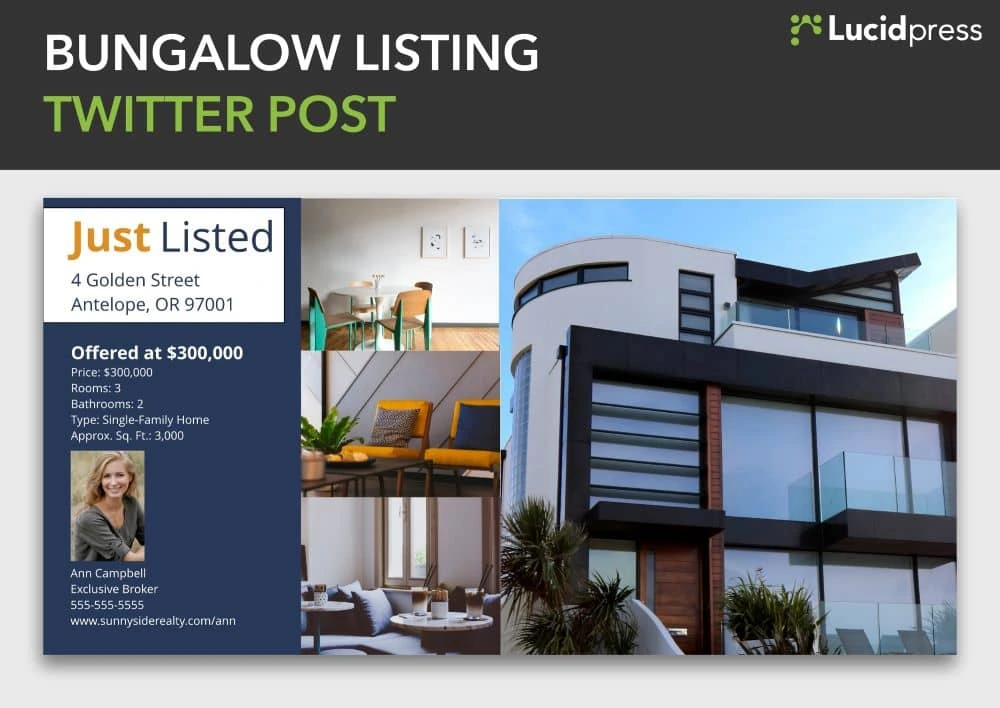
Social media for real estate tip #7: Remember your past clients
Social media is a great tool for realtors to build relationships and land clients. But, that’s only part of its appeal. It can also help maintain relationships you’ve already developed.
What happens when those closing papers are signed? Clients feel a rush of adrenaline, but after a few months, everyday life creeps back in. An incredible 70% of homeowners can’t even remember their real estate agent’s name one year after closing.
It’s a shame to have those relationships slip away after you’ve spent so much work building them. With a little social media love, it’s much easier to maintain them. That way, when clients are ready to move again or recommend a realtor to family or friends, you’ll be the first person who comes to mind.
How can you do this on social media?
Release a steady stream of that evergreen content we mentioned earlier. Brainstorm all the things you wish you knew when you moved into a home. Is it design inspiration? Checklists to get organized? Ways to prepare for the winter or save money on utility bills?
You can also broaden your content from real estate itself. Now that your client has moved, they’re living, working and integrating into the community. They might be interested in that new restaurant down the road. Or the best summer camps to send their kids. You can become their go-to source for all things local.
Social media for real estate tip #71/2: Measure and keep learning
You’re sending emails to clients, working open houses, and putting out yard signs. (Not to mention trying to keep up with your own personal life.)
You don’t have endless hours to pour into social media that isn’t paying off. How are your tweets performing compared with your Pinterest posts? Should you be posting on Facebook or focusing on Instagram?
These are the questions that can frustrate you to no end. Instincts might give you some indication, but measuring will let you know for sure.
Fortunately, it’s never been easier to collect data on social media performance. It’s easy to see which posts get the most engagement in terms of likes, retweets and comments. But, if you’re looking to see what’s really moving the needle in terms of sales, why not create unique landing pages for each platform?
A landing page simply directs visitors whenever they’re interested in contacting you, seeing a new listing, and so on. Tailoring them for each social media platform allows you to track where leads come from. You can also find out a lot more about each user’s interactions with your brand and their path to becoming a client.
Keep an eye out on which platforms, campaigns and topics perform best. As long as you keep tracking your analytics and tweaking your strategy, it will gradually get more effective. This optimization process never ends, but the payoff increases over time.
Over to you
Social media has become an essential piece in every realtor’s marketing toolkit. Thankfully, it doesn’t have to be overwhelming anymore. Apply the tips above while launching your real estate marketing strategy, and you’ll build an impressive audience, engage them, and bring in more business.
Kickstart your next social media campaign with our free templates for real estate.
If Instagram feels unavoidable these days, it’s because it is. The social media giant has over 1 billion monthly users and 90% of them follow at least one business. Needless to say, it’s smart to have an Instagram presence for your brand.
A business Instagram account can seem imperative, and they’re also a lot of work. To keep your followers engaged and maintain a consistent brand presence, you’ve got to post regularly — at least a few times a week. All that posting means you’re going to need a solid social media planner (maybe even a team!) to get your content ducks in a row.
Related: Free Instagram post templates
Coming up with content for Instagram can get old quick: You’ve got to strike the right balance of human-interest topics, brand promotion, aspirational content and customer engagement. Just posting high-quality images isn’t enough to drum up excitement for your brand. You also need to know how to drive engagement and which types of posts can boost sales. Here are 6 tried-and-true Instagram post ideas to help you get started.
What to post on Instagram
1. Endorsements
“Influencer” has quickly gone from being a kind-of-funny thing to becoming an actual profession. Influencing sells, period. People are genuinely interested in what other people are doing, and we love a recommendation.
And even if you’re not ready to hire a handful of socially adept personalities who shine in front of a camera, you can always lean on endorsements and product reviews from other people — whether that’s a well-known celebrity, industry expert or an average joe.
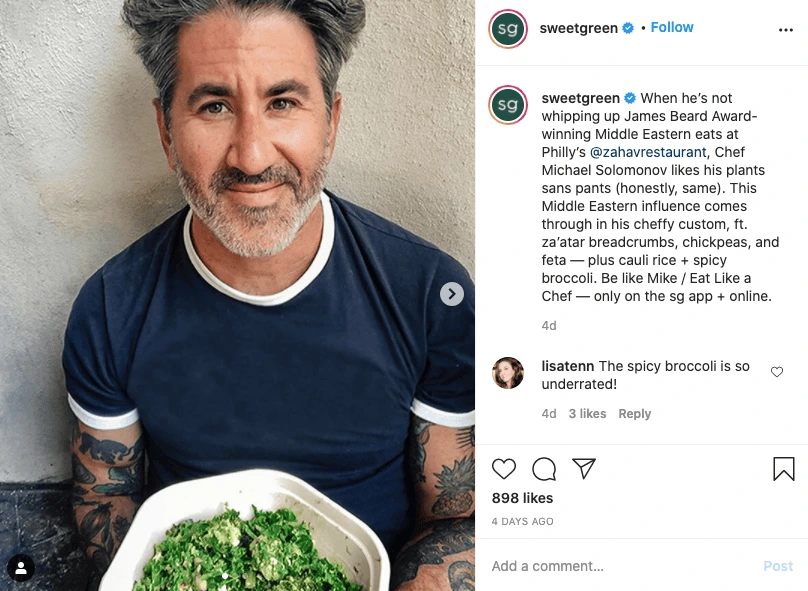
Source: Sweetgreen
Sweetgreen regularly posts content that features chef’s favorites from their restaurants. This does a few things:
- It offers social proof. It lets you know that experts in their field (chefs with highly refined taste buds!) frequent Sweetgreen, i.e. the food must be high quality and delicious.
- It satisfies curiosity. What are successful, talented people eating at Sweetgreen? Now you know.
- It’s far more interesting than a bland product-promotion post. Having someone else recommend your product and put their own spin on things helps spice up the content.
There are lots of different ways to feature endorsement-related content that will entice your followers. Brainstorm how you can use your current customer base to review, endorse or promote your products on Instagram.
2. Giveaways
Let’s be honest: Everyone loves free stuff.
It’s no secret that the word free is powerful, and many marketers use it in their copy to grab shoppers’ attention. That’s why samples and giveaways have become such a popular promotional tactic.
When you give away your product, you attract a larger audience of people willing to try your brand. It’s an opportunity to build brand awareness and encourage shoppers to try your product before buying it. Plus, it lowers the risk of trying something new.
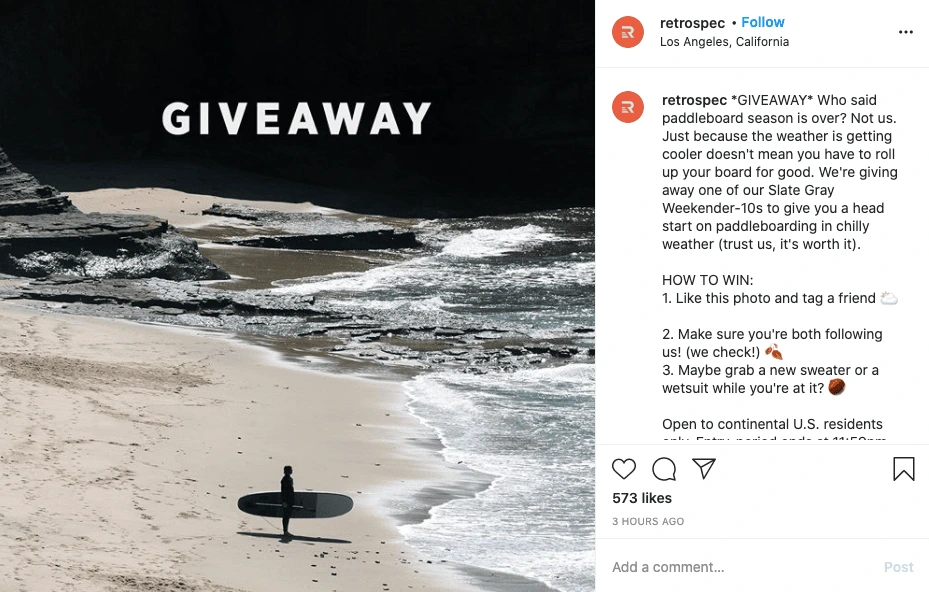
Source: Retrospec
Take Retrospec, for example, who gave away a much-sought-after paddleboard to keep their followers interested and engaged.
Since people love free stuff, this type of post often goes viral, attracting more followers who want a chance to win. If you want everyone to feel like a winner, you can even offer a discount to all entrants.
One point of caution: Not everyone who enters your giveaway will be interested in your brand. While the engagement may be impressive, you’ll likely notice a drop in followers once the promotion is over. That’s okay—those who leave probably aren’t a good fit for your target audience, and the ones who are will stick around.
3. Lifestyle photos
If you’re trying to sell a service rather than a product, give lifestyle content a try.
When you create an atmosphere that resonates with your followers’ lifestyle (or desired lifestyle), your brand feels more authentic. Don’t focus on your service; focus on your potential customer.
For instance, Sotheby’s International Realty uses lifestyle photography to hint at what clients can expect from their services. But it’s not about selling real estate, it’s about selling the lifestyle — sophisticated, comfortable and luxurious.

Source: Sotheby’s International Realty
Lifestyle photos can help people imagine how they might feel after engaging with your brand. If that lifestyle speaks to their desires and sensibilities, this Instagram post idea can easily contribute to future business.
4. Inspirational quotes
We all have moments when we need to motivate ourselves. When you’re looking for a quick pick-me-up, the right inspirational quote can really lift your mood.
Even though inspirational content doesn’t always contribute directly to sales, it helps to illustrate your brand’s values. Plus, it has more potential to go viral, as people like to share content that reflects their own values, too.
Below, SoulCycle offers a thought that would be sure to make you pause if you saw it while scrolling through your feed. Short, relevant quotes like this can inspire your community.
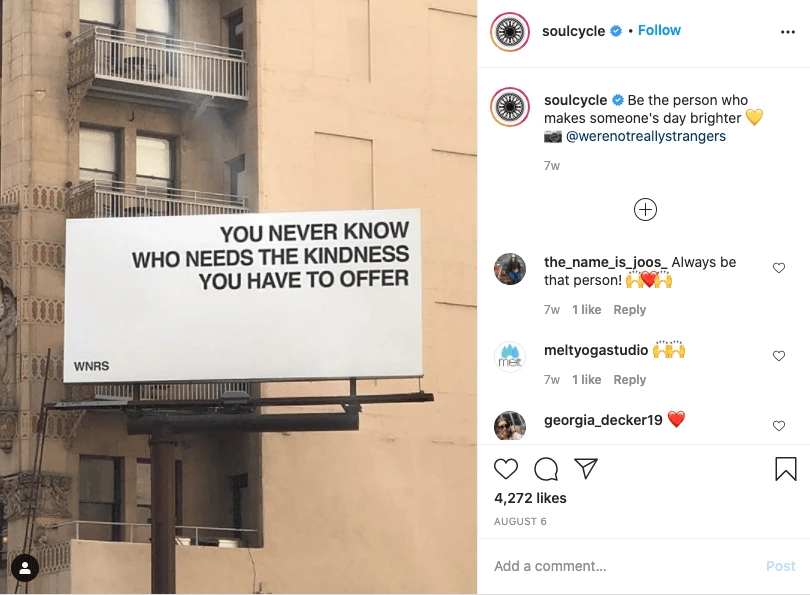
Source: SoulCycle
Sometimes less is more — and when it comes to Instagram, think first and foremost about fostering brand loyalty. If people draw inspiration from your brand, they won’t forget you.
5. Brand achievements
Your brand story matters to your customers, and so does your success.
When you share your brand’s achievements, you build trust and reinforce loyalty, which often leads to sales, support or donations. Reputation plays a big role when it comes to spending decisions, and your achievements prove that you’re a successful organization.
World Wildlife Fund often highlights its accomplishments on Instagram, showing its patrons and followers that their financial support is being put to good use. Content like this does double duty: It gives followers’ feeds a boost with good-news stories and it promotes the brand’s work.

Source: World Wildlife Fund
Achievement comes in many forms — brand development, product launches, customer growth, charitable initiatives — so keep your eyes open for opportunities to tell your story on Instagram. You might be surprised by how creatively you can visually represent your brand’s success.
Watch for ways to build trust and reinforce loyalty with your followers. Sharing your brand’s success will improve your reputation and impress potential customers.
6. Limited-time offers
As social creatures, it’s human nature to hate missing something important. Marketers should use FOMO (fear of missing out) to their advantage. One example is a limited-time sale, coupon or discount.
Take a look at Nékter. This franchise knows how to use sales to grab attention and encourage repeat purchases. How do they do it? Descriptive captions, a clear offer and bright, detailed photography all work together to deliver a compelling offer.
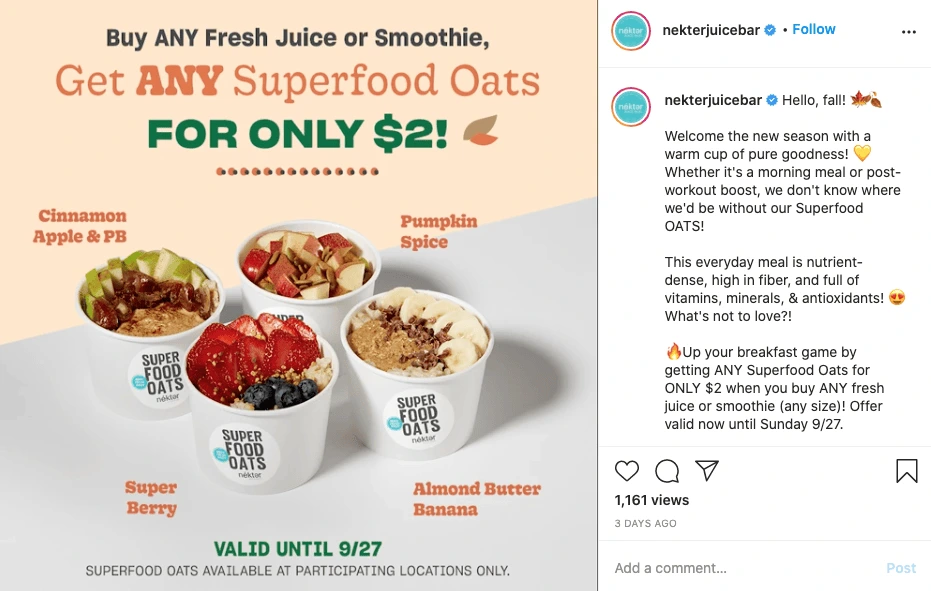
Source: Nékter Juice Bar
Nothing delays action more than uncertainty. Run your sales for a short period of time to give your followers a clear understanding of when and how they should act. If you run sales all the time, your audience will adjust and expect discounts continuously. Instead, make them feel like they’re getting a real deal by purchasing now.
Use compelling visuals to announce your offer, then provide followers with a clear deadline to increase urgency.
Key takeaway
Over the past few years, Instagram has evolved into a powerful marketing platform that gives brands new opportunities to boost sales. Investing in the right kinds of Instagram post ideas is a strategic way to influence the buying process.
When Instagram rolled out 24-hour Stories back in 2016, it became a sensation overnight. Almost eight years later, the feature is still going strong, and many marketing teams have made it a fun part of their social media strategy. But there’s an art to this seemingly simple feature – and simply posting and hoping for the best isn’t it. If you want to use Stories strategically, you’ll need to delve into your target audience and figure out your brand’s visual identity.
In this quick guide, we’ll walk you through how to use Instagram Stories strategically, with some great examples to give you a head start.
What are Instagram story filters?
Of Instagram’s more than 2 billion users, 500 million of them watch at least one Story per day. And while overall Story reach rate has declined over the past few years, they’re still an incredibly sticky feature, with a full half of Instagram users reporting that they’ve visited a brand’s website to check out or buy a product after seeing it on Stories.
By these stats alone, it’s abundantly clear just how powerful Instagram Stories are for brands large and small. But numbers aside, there are several strategic reasons to have a solid Instagram Stories plan in place, including:
- Instagram Stories humanize your brand: Unlike our highly curated feeds, Instagram Stories are meant to be ephemeral (they only last 24 hours), timely, and authentic. They’re the perfect medium to showcase the real people, stories, and values behind your brand.
- Stories are much harder to miss: While the IG algorithm used to show posts in your feed in the order they were posted, that’s no longer the case. That means that your shiny new posts might not actually be seen by some of your audience. But when you post a Story, your followers will see it above their feed, and might even get a notification about it.
- You can share links: One of the biggest complaints marketers have about Instagram is that you can’t share links in regular posts. Thankfully, if you have a business or creator account, you can share clickable links in your Stories, making it much easier for your followers to check out your website.
- More opportunities for engagement: Other than commenting or liking, there isn’t too much a person can do with a regular in-feed post. But with Stories, users can respond to polls, share direct messages, ask questions, and more.
Tips on how to use Instagram Stories
Want to make the most of your Instagram Stories strategy? Here are a few tried-and-true tips:
Create a consistent visual identity
If one of your followers randomly stumbled upon your Story without any context, would they know it was from your brand? If the answer is ‘no’, then it might be time to rethink how you’re approaching your brand’s visuals. Brand consistency is key to making your content recognizable, memorable, and most importantly, effective.
So what does this mean in practice? We’d recommend starting by using the same color palette, fonts, and imagery you use in other branded materials. For example, if your website uses a lot of plant and nature imagery, your Stories should as well.
Post often
Like with any social media strategy, it takes time to see the fruits of your efforts. Don’t get discouraged and quit cold-turkey if you don’t see a lot of results after just a few weeks or months. Posting great content on a consistent schedule is essential to building up a dedicated audience over time. Research shows that around 2 stories per day is the ideal, but feel free to experiment and see what works best for your brand.
Avoid too many frames
No one likes the person who spams posts on their IG feed, and the same goes for Stories. According to Rival IQ, the number of people who stick around to watch your Stories drops off below 75% after 7 frames.
Experiment with storytelling
Storytelling is one of the most powerful tools you can use as a brand. And when it comes to IG Stories, narrative-based content wins, with 35% of users preferring short narratives.
A few ideas here:
- Walking users through a how-to or tutorial
- Sharing your brand story
- Taking your audience on a ‘day-in-the-life’ of one of your employees
- Showcasing stories from your customers
Use CTAs
Just like with any other type of social media post, your Instagram Stories should point people in the direction you want them to go. A call-to-action, like a clickable link or interactive poll, incentivizes people to engage with your Story and account.
Some of our favorite Instagram Story examples
Outdoor product Instagram story template
Got a seasonal launch or sale coming up? This customizable Instagram Story template offers an eye-catching way to detail several different products at once.
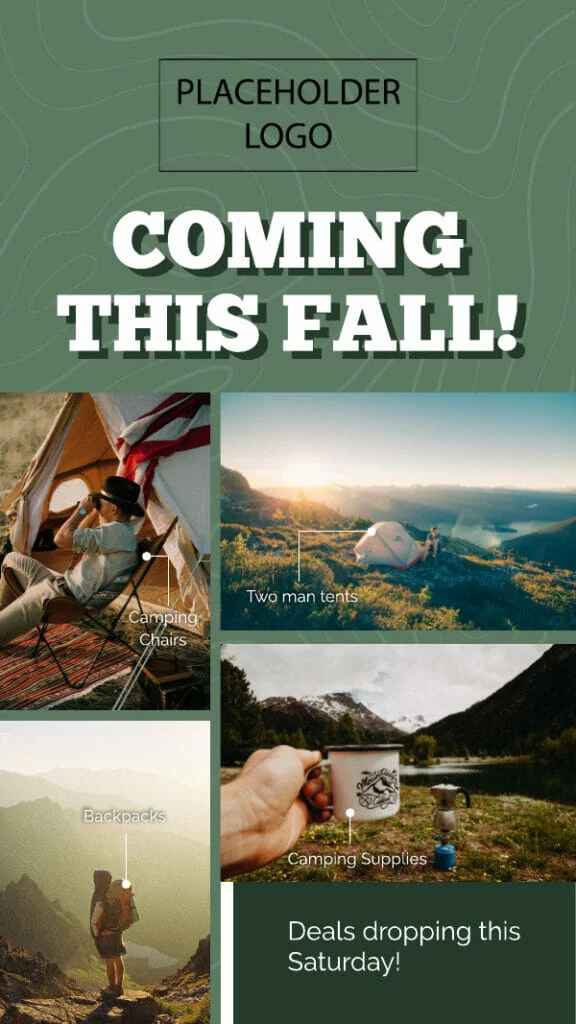
America’s Test Kitchen
If you want people to engage with your brand, ask them their opinion! This simple Instagram Story from America’s Test Kitchen is a great example of how to easily boost engagement, all while subtly driving people to your website for more.
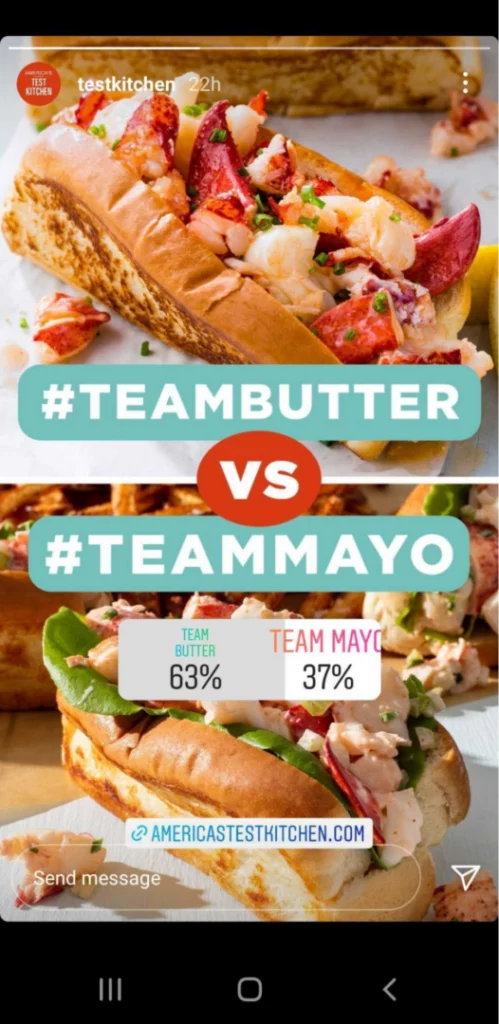
Work from home Instagram Story Template
Customizable bingo is another fun way to gamify your content and get people interacting with you. Choose an on-brand bingo theme and invite people to screenshot and tag you in their own Story. If someone gets bingo, repost it back to your Stories!
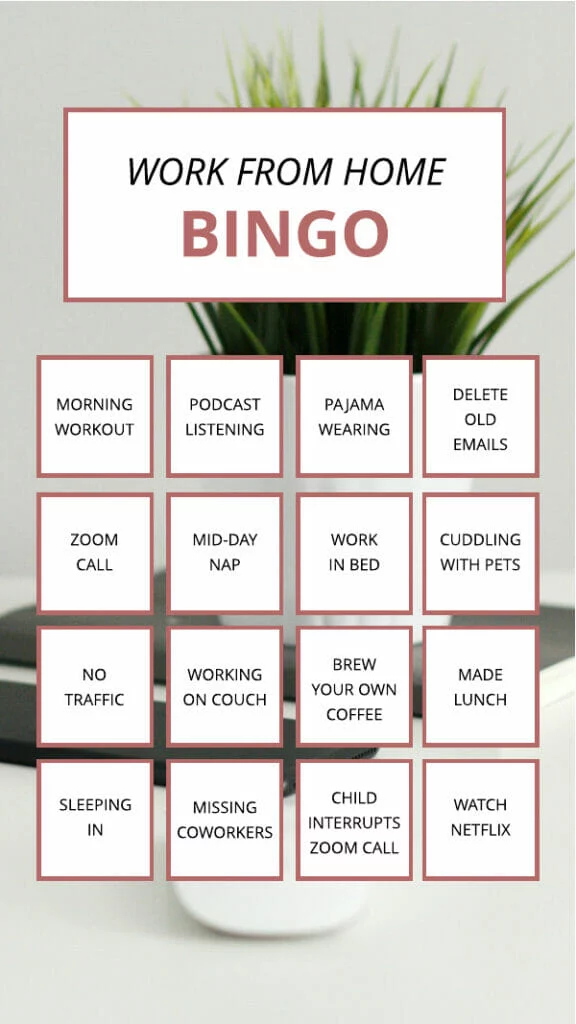
Nike
We love what Nike did here with their short-form video IG Story series. They sat down with some of their athletes for a short look into their career accomplishments – and didn’t mention any of Nike’s products. It’s a masterclass example of using compelling storytelling to your advantage. Not everything you post has to tie back to your product or service, but it should reinforce your brand and what it stands for.
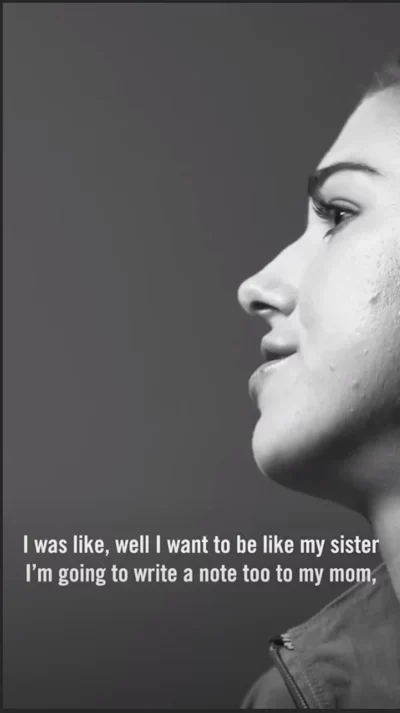
With Instagram Stories, the possibilities are pretty much endless. Not sure where to start? Check out Marq’s free template library full of customizable Instagram Story templates and get creating!
Instagram is one of the fastest-growing social media platforms, with over one billion monthly users spending up to an hour a day perusing the app’s vibrant, visual content. Home to the influencer and brand ambassador, Instagram allows powerful companies and small businesses alike to level the playing field and connect with prospective customers.
Instagram says 90% of its users follow at least one business account, and two in three Instagram users confirm the app drives their interactions with brands. While you might not be Nike with 133 million followers, Instagram can still be a lucrative space for small businesses to leverage.
Why small businesses should use Instagram for business
Instagram business usage has exploded in the last few years among brands that realize the platform’s potential to reach younger audiences. With dynamic video and lifestyle content, Instagram is an ideal space for marketing campaigns, product launches and brand building.
Because this social media community has a mobile-first approach, it can seem intimidating to small businesses. But if you’ve been lukewarm about launching a business account, now is the time to establish your Instagram presence and take advantage of the exposure this popular platform provides.
How to set up your Instagram business account
If you’ve been tinkering with a semi-official personal account, take the plunge and switch your profile to a business account. If you don’t have an Instagram presence yet, create a personal account first, then switch it over to a business profile.
Confused about how to get started? Pop over to Instagram for Business and get the official Guide to Getting Started for detailed instructions and more information.
Instagram doesn’t allow much to be packed into your profile, so make sure your bio is succinct with contact information such as your company’s website. Think carefully about including branding elements in your profile pic to make your business stand out in a sea of selfies and carefully staged photos.
Learn more about types of Instagram content
Once you’ve got a profile established, it’s time to populate it with content. Just remember that not all eye candy is created equal. The kind of content you choose to invest in may differ depending on your business goals. Here are the basic types of content available on Instagram.
Instagram Posts
Because Instagram is a visually driven platform, every post begins with a photo or video. While you’ll have plenty of space to caption the image and include details, the picture is the focal point of every good Instagram post.
But fantastic photography isn’t going to distinguish your business profile from all the visual noise on Instagram. Instead, engage your audience through diversifying your Instagram posts and content. Need some inspiration? Lucidpress has some Instagram post ideas proven to boost sales.
Instagram Stories
This Instagram feature splices together video and photos into a story that expires in 24 hours. Creator-generated filters for Instagram stories use AR and other effects to layer over your content for a signature Instagram experience.
New to Instagram stories and need a little hand-holding until you get the hang of it? Lucidpress has Instagram story templates to get you started.
Instagram Reels
For users who dig TikTok, Instagram Reels provides a similar approach with short videos you can share. Overlaid with filters, music and other effects, Reels is a handy way for brands and small businesses to showcase products and share behind-the-scenes footage.
IGTV
You guessed it. IGTV stands for Instagram TV. It’s a channel dedicated to promoting longer videos of up to 10 minutes. Bonus points if you’ve got a verified account because you’ll get the perk of posting 60-minute videos. Businesses use IGTV for tutorials, Q&A sessions, and customer success stories.
Instagram Shops
While all of this brand-building content is a plus, you need a way to monetize and convert traffic from your business social media accounts. That’s where Instagram Shops comes in with a shopping experience that works seamlessly with Instagram and helps convert followers into customers.
Use these Instagram engagement strategies to boost your business profile
Boost your Instagram engagement, grow your following and expand the reach of your content with the following strategies.
Leverage hashtags
The best way to make a splash on Instagram is to ride the wave of trending topics. Instagram’s search feature is driven by hashtags, so tagging all your content with relevant hashtags is an easy way to increase reach.
While you can use up to 30 hashtags per post, more isn’t always better. On Instagram, you’ll get more traction from hashtags that are trending. Avoid randomly throwing in trendy topics that don’t apply to your content, though, or you’ll risk seeming spammy.
Sponsor contests and giveaways
Who doesn’t love free stuff? Instagram is a great place to promote giveaways that’ll garner attention and shares. And while you should take engagement on these tantalizing promotions with a grain of salt, it’s still an excellent opportunity to find new followers and recruit lifelong customers.
The most successful giveaways and contests on Instagram have a few things in common. First, they run for a short period of time and provide exclusive products or content for those who participate. Secondly, using branded visual elements and customized hashtags boosts shares and organically expands the reach of your promotion.
Encourage collaborations
Influencers and brand ambassadors with large followings make a legitimate living on Instagram by amplifying products and campaigns they care about. You can leverage that influence for your small business, but successful collaborations come with some caveats.
It’s vital to do research and connect with an influencer who has some “social proof” or credibility in your industry. While a Hollywood celebrity account reaches millions, those fans may not be the best market for your product or brand. You also don’t have to spend a hefty chunk of change to make successful collaborations or sponsor a post. There are plenty of influencers who have fewer followers but work with niche audiences that could be a great fit for your Instagram business.
Create valuable content
Whether you use Instagram for business or personal reasons, there’s a simple rule to gaining followers. Create high-quality content that people care about. Instagram has a strong level of user engagement, so figure out what your audience wants and deliver it consistently. From how-to videos to deep-dive infographics, don’t hesitate to explore the passion behind your product or brand.
Another way to make sure your business is creating valuable content is to ask yourself if what you’re sharing on Instagram builds community. While some accounts might chase clout, ultimately the brands that have high levels of engagement are those that have built trust with followers.
Write compelling captions
Instagram is visually-driven, but captions are your last and best chance to communicate with your customers. Write compelling captions with these simple rules.
- Start with a good hook. Instagram makes you click to read past the first 125 characters, so make sure people want to read on.
- Place keywords at the beginning to capture attention.
- Get expressive with emojis.
- Sneak in trending hashtags at the end.
- Don’t forget a CTA or a question to boost engagement.
Maintain visual and voice consistency
Before rolling out the red carpet on your brand new Instagram presence, think carefully about your brand voice and values. How can you communicate what you care about through the visuals on your Instagram business profile?
Whether you’ve decided to keep it consistent with a certain color palette or using humor and wordplay to show off your products, you can keep your Instagram vibe consistent with Lucidpress Instagram post templates.
Measure results
Using Instagram for business puts a wealth of data at your fingertips to measure engagement on your posts and tweak campaigns to produce better results. The reporting tools aggregate data into a single dashboard, so you can glean insights at a glance. You’ll see overall stats for your business profile, and you’ll also be able to drill into post engagement to find the best performing hashtags and content. Learn more about how to use Instagram insights for your business over at Facebook’s Business Center.
How to use Instagram ads
Advertising on Instagram is relatively cost-effective and accessible for small businesses. If you already have a Facebook advertising account for your business, Instagram for business will look familiar since it runs on the same platform. In some cases, you can cross-promote campaigns or content across both Facebook and Instagram.
Before you dial in the details of your Instagram ad campaign, make sure you’ve articulated your goals. Whether it’s to increase followers or convert customers, your objectives will determine factors like ad placement, targeted audience, budget, schedule and the ad format. You can learn more about how to create effective Instagram ad campaigns at the Instagram for Business center.
Designing a dynamic Instagram presence for your small business won’t happen overnight, but if you commit to creating high-quality content, you’ll convert casual followers into lifelong customers for your small business.
Get started elevating your Instagram profile with Lucidpress’s Instagram templates.
When Instagram rolled out Stories in 2016, it became a social media sensation. Since then, the use of Instagram stories has skyrocketed, with an estimated 500 million people engaging daily. Because of its reach, Instagram Stories are a fantastic business marketing tool for small businesses and large brands alike.
As you peruse the platform, you’ll see creative Instagram story ideas on display, from quick videos to fun quizzes. Consistently coming up with fresh content for your Instagram Stories may seem like a stretch, but get into a groove and you’ll discover endless inspiration to pursue. Let’s explore some of the best Instagram story ideas to strut your brand’s stuff.
Ready to get creating? Find the Lucidpress Instagram story template that’ll make your Instagram story ideas pop.
20 of the best Instagram story ideas to engage your followers
1. Feature tutorials
The best way to gain a loyal following is to give your followers more of what they want when they want it. Tutorials describing how to make or use your product or services don’t have to be lengthy diatribes. Even short videos or custom graphics offer valuable insights to your audience.
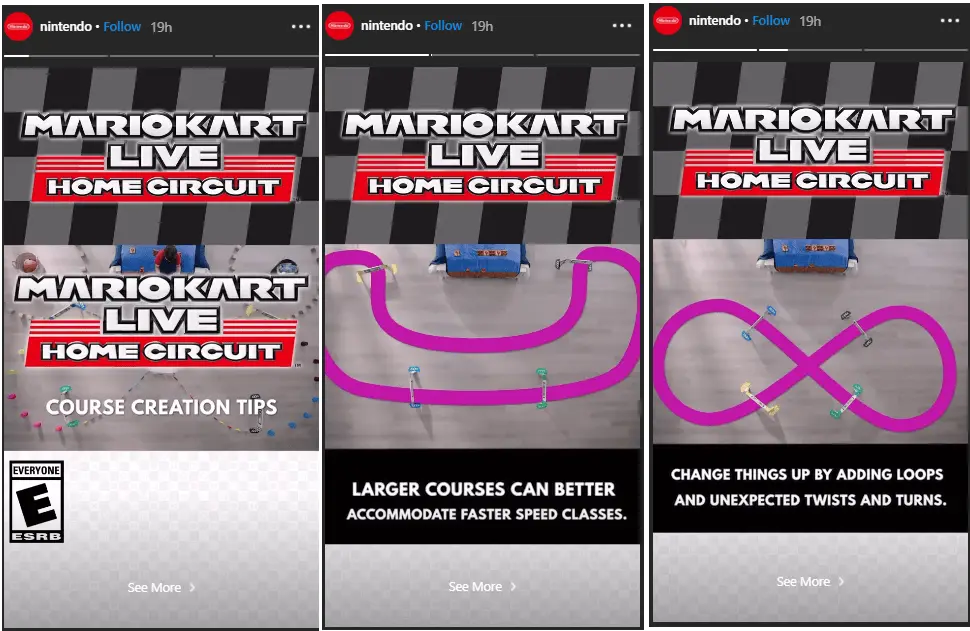
2. Offer freebies
Free is everyone’s favorite word, so feature contests and giveaways prominently as part of your Instagram Stories. Create branded graphics and think outside the literal box. Free trials, consultations and even collaborations with other businesses are part of a good giveaway strategy. If you’re hosting a contest, use a custom hashtag and ask participants to tag you to enter.
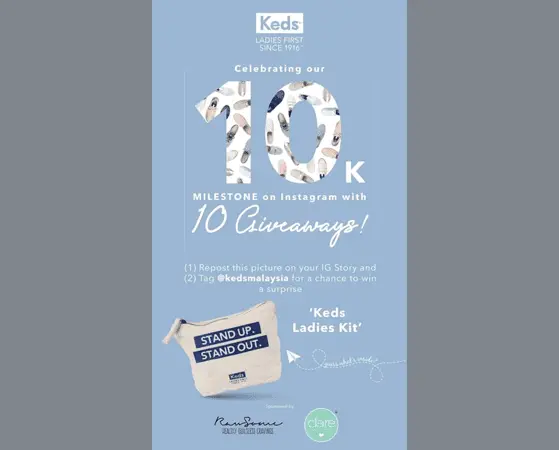
3. Polls, polls, polls
Instagram offers quite a few stickers to make stories sing and increase clickability, and poll stickers are one of them. Providing choices makes your followers feel like part of the conversation and boosts audience engagement. You can use polls to gather feedback, highlight a product or just spice up your profile with a little fun for everyone.
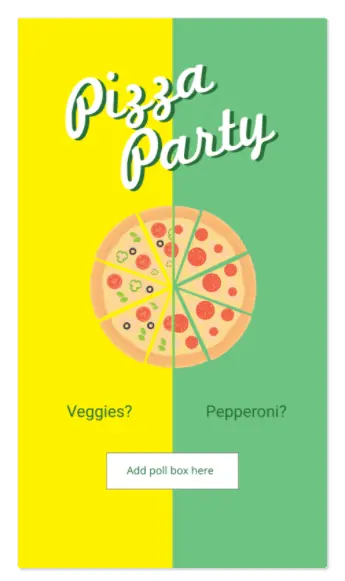
Get this Lucidpress Instagram story template HERE.
4. Show off the before and after
You don’t have to download a fancy photo editor to do before and after comparisons in Instagram Stories. Simply superimpose text on images and string them together as part of a peek at a transformation in progress. Before and after highlights can be a great strategy for cosmetic services, photo editing, home improvement projects, product or brand updates and much more.
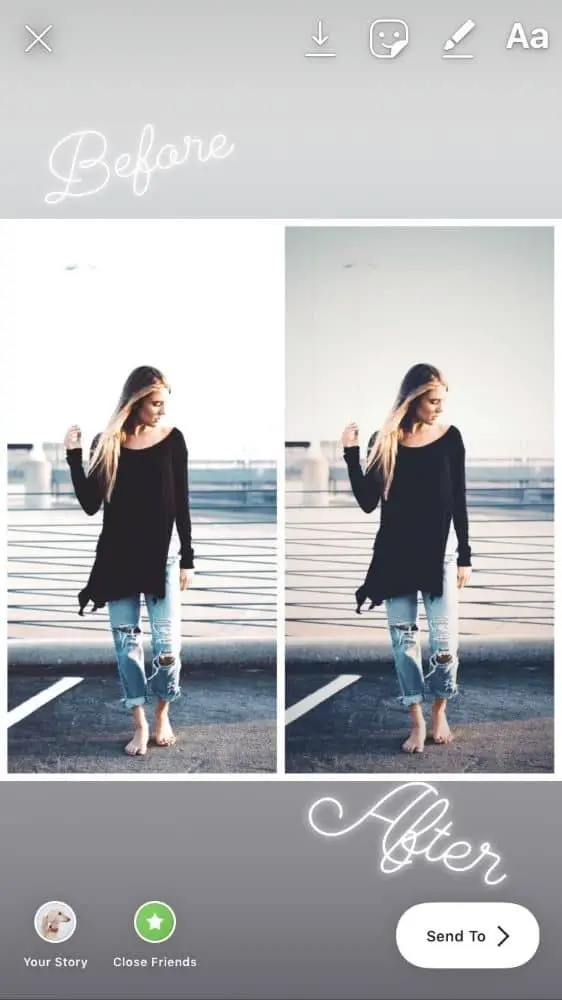
5. Choose this or that
Give your followers a little customizable content with a fresh take on the “this or that” questionnaire. These templates work as downloadable graphics where followers can circle or cross out choices and repost the completed copy on their own Instagram story. From food to travel to memes, it’s easy to populate this-or-that templates with topics that’ll align to your brand and pique your audience’s interest
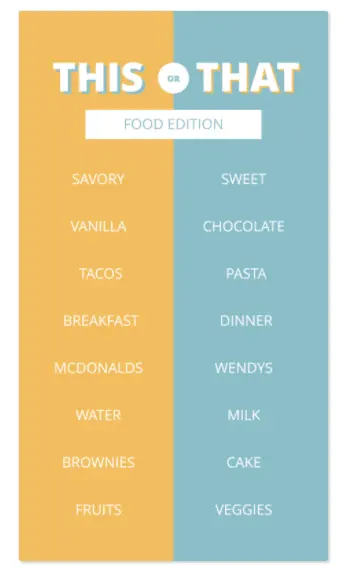
Get this Lucidpress Instagram story template HERE.
6. Stage an Instagram takeover
Move over and make room for an Instagram takeover. This Instagram story idea is exactly what it sounds like. In a takeover, your business allows someone to commandeer your account for a short period. A takeover involves allowing employees, influencers, competitors, and even customers to take the wheel. Letting someone else drive can generate clever clips to spice up your Instagram Story ideas and attract new followers.
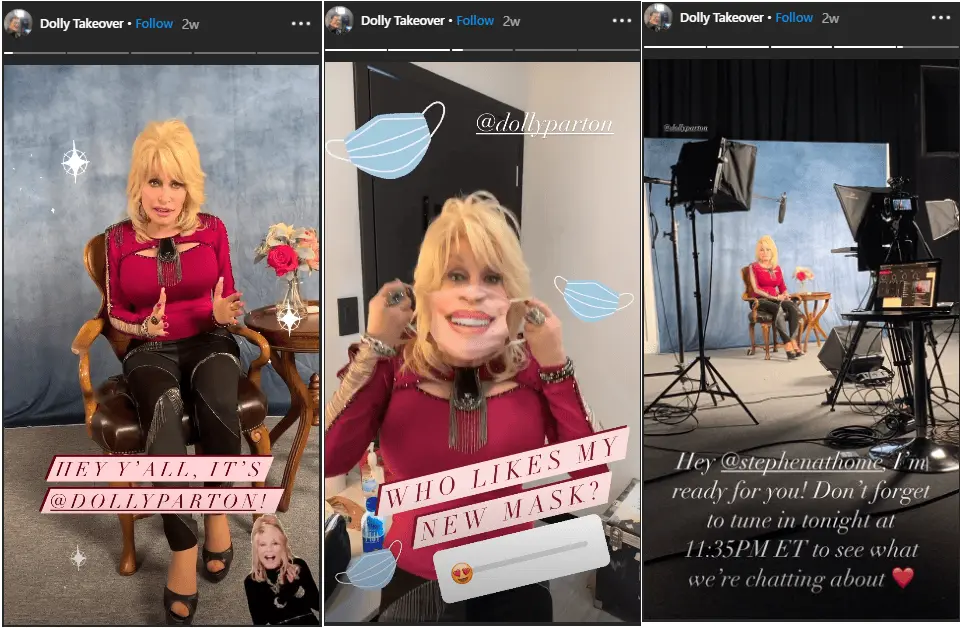
7. Go behind the scenes
There’s nothing more fascinating for brand enthusiasts than seeing how the secret sauce is made. Give them a peek behind the scenes in your Instagram stories with tours, bloopers, reels and exclusive content that lifts the veil between product and producer. Letting your audience see the mess behind the magic lends a uniquely human feel to your social media presence.
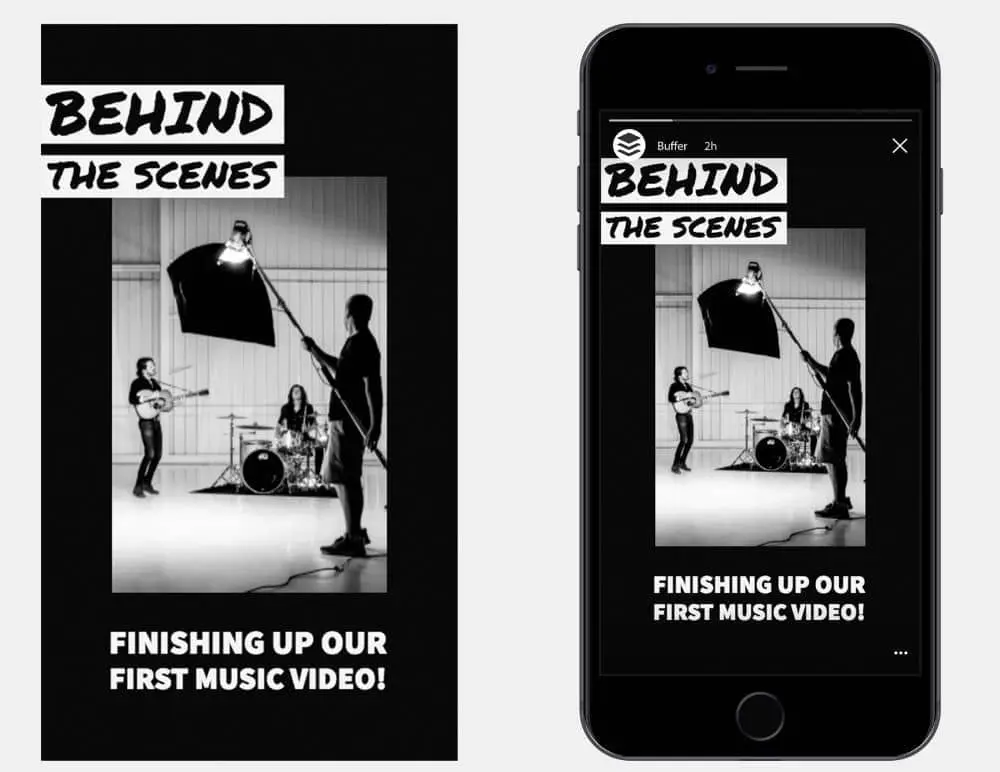
8. Interview an employee
Your greatest asset is your employees, so hand over the microphone and let them speak for themselves. Choose an employee who has a compelling personal story or insights that align well with your brand. Then step aside and let employees use Instagram Stories as a platform to educate your followers in their area of expertise.
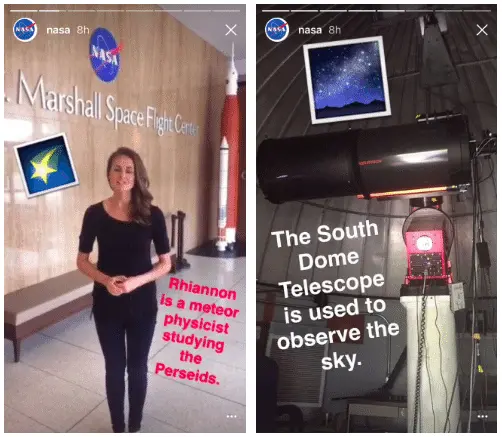
9. Promote a blog post
Building a following on Instagram is a worthy goal, but most businesses are also looking to boost traffic to a website. Instagram Stories is a solid strategy for promoting posts and directing followers to your blog. Take a few tantalizing snippets from your latest post and pop them into a visually appealing template. Then use the Instagram story swipe-up option or sticker to direct users to your website for more.
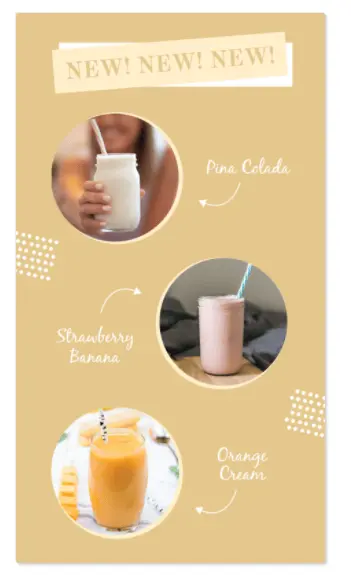
Get the Lucidpress Instagram story template HERE.
10. Play bingo
You don’t have to leave the couch (or Instagram, for that matter) to play bingo. Create a quirky, custom take on this traditional game that aligns with your brand. Books, movies, memes, emojis, food and much more are all fair game. Users upload the image you create to their camera roll, use the drawing tools (located in Stories) to mark it up, and repost to their own timeline or story.
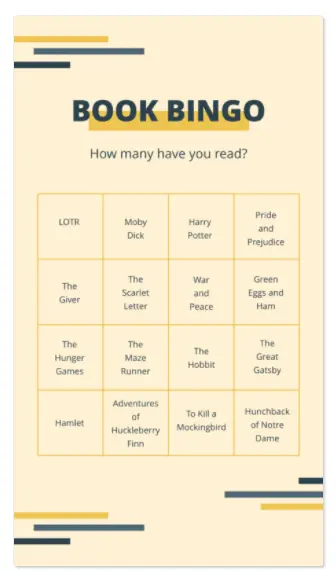
Get the Lucidpress Instagram story template HERE.
11. Solicit suggestions
Not sure what your followers want? Go ahead and ask them. Solicit Instagram story ideas, new products, or just general feedback. If you’re brave, you can encourage followers to connect via direct message with their insights. Once you’ve gathered these fantastic tidbits, don’t let them go to waste. Share them in subsequent Instagram stories so your followers can benefit.
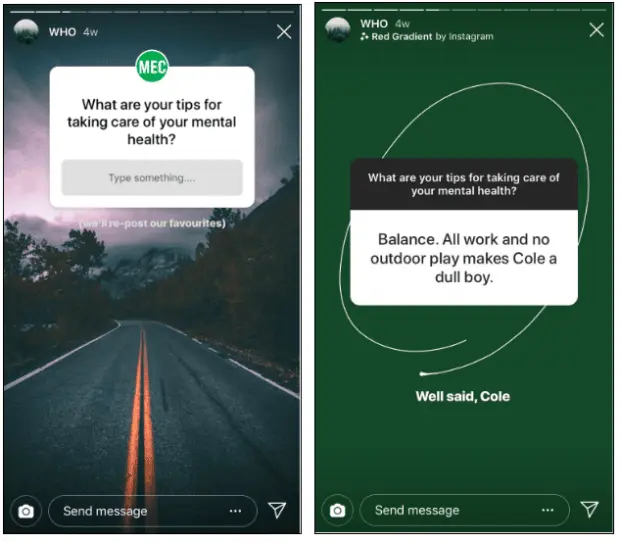
12. Share and link to CSR campaigns
Many companies have chosen to invest in promoting corporate social responsibility campaigns, and your Instagram Stories can be a perfect spot to highlight that work. Once you’ve shared a branded graphic on the campaign or community action you’re supporting, don’t forget to use the Instagram mention sticker to direct followers to where they can learn more or donate.
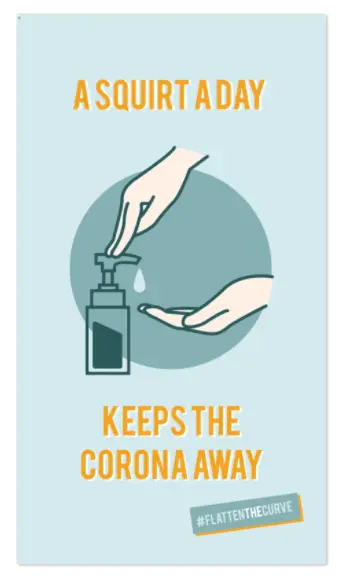
Get the Lucidpress Instagram story template HERE.
13. Design a shoppable story
Embedding a shopping experience into your Instagram Stories is a surefire way to convert followers into customers. Highlight your product with a little eye candy and include an Instagram sticker to swipe up and take users off-site. Be warned that not every business qualifies for shoppable stickers. Brands must have a business profile and offer a physical product that complies with Instagram’s policies.
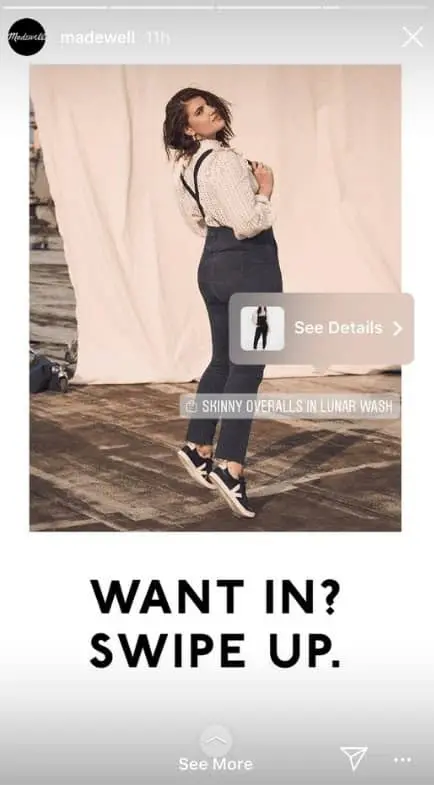
14. Create a quiz
Enough about you. Let’s talk about your followers. Quizzes give your audience a chance to weigh in and discover more not just about themselves but also about your products, services, or brand. Start a story and select the quiz sticker to create a series of questions for your followers to answer. You can customize colors and other elements for a branded effect.
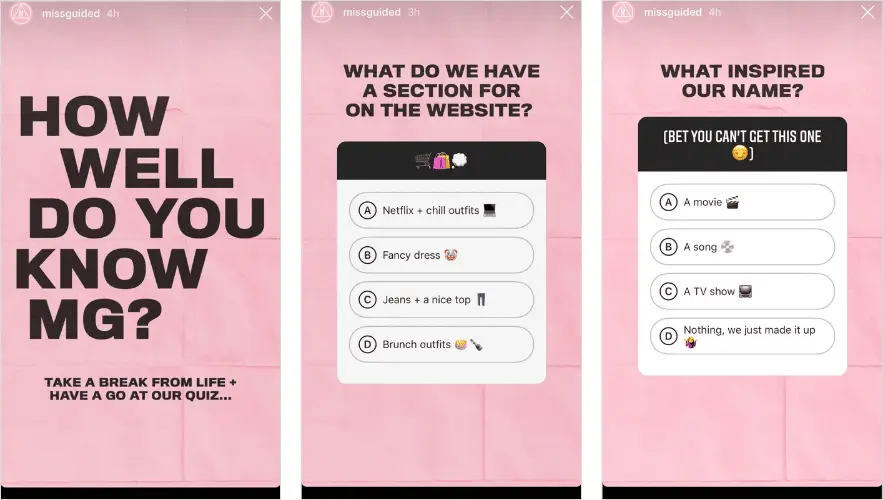
15. Do an unboxing
Unboxing videos aren’t just for YouTube anymore. Watching someone unpack a basket of goodies is profoundly satisfying for viewers, but it’s also a creative way to showcase your products. Even if you don’t offer a physical product, creative Instagram users can partner with affiliates to do an unboxing video.
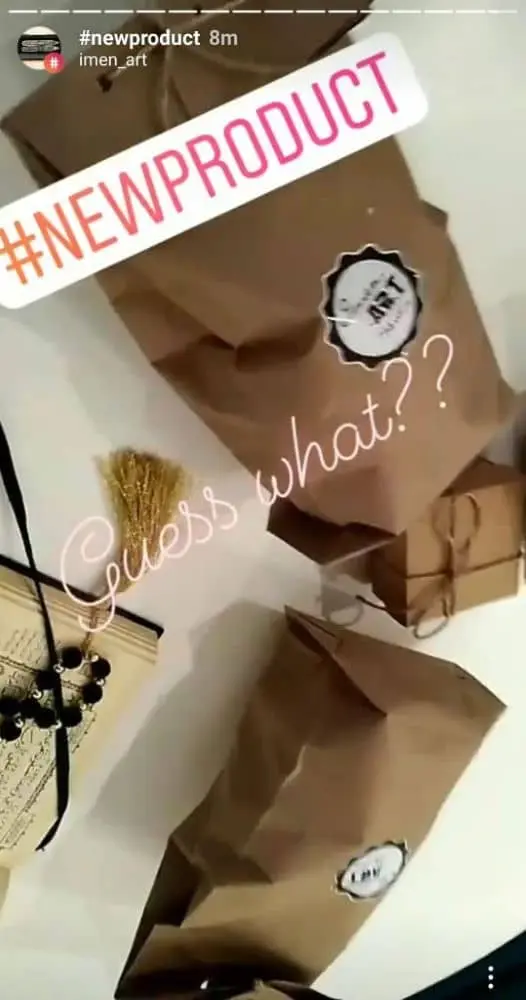
16. Go live
Half the fun of Instagram Stories is that they feel exclusive because they have an expiration date. Going live in your Instagram Stories is a way to directly engage with your audience and keep them checking your social media content daily. Notifications that you’re live go out once you start rolling, but for maximum impact, brands follow a consistent schedule and advertise live sessions in advance.

Get the Lucidpress Instagram story template HERE.
17. Promote a product or service
Finding unique ways to connect with followers on social media is crucial, but at the end of the day, your business exists because you have a product or service that meets a need. Show off your stuff in your Instagram Stories with branded graphics, promotional offers and periodic reminders that you take pride in the work you do.

Get the Lucidpress Instagram story template HERE.
18. Feature a testimonial
Testimonials are powerful social proof, so don’t hesitate to flaunt your glowing reviews. Pick the cream of the crop and pop them up on your Instagram Stories periodically. You can give these testimonials a polished feel or a little signature flair by repurposing branded quote templates.
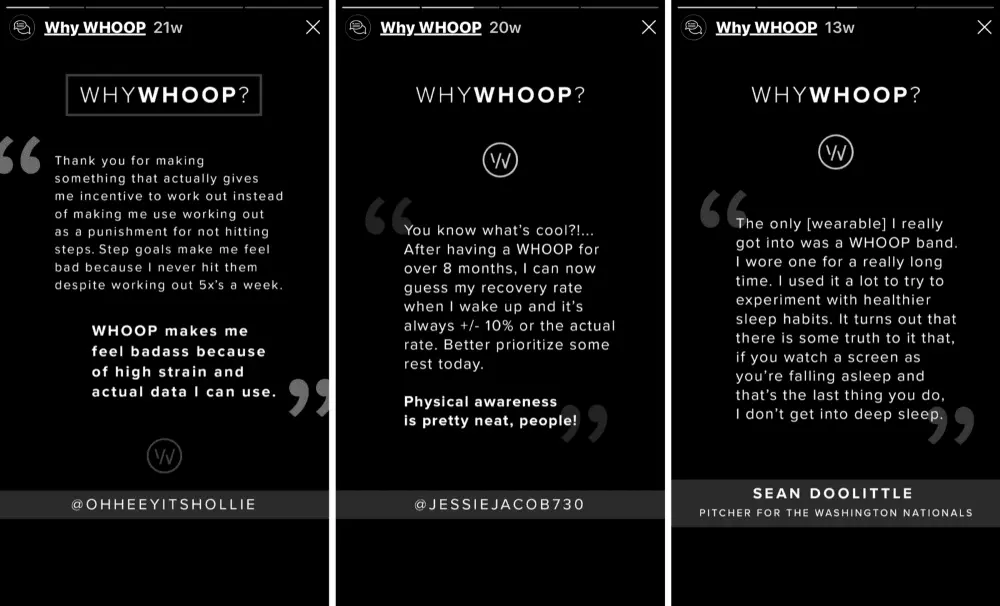
19. Give a sneak peek
Got something great in the can? Start generating buzz with a sneak peek on your Instagram Stories. Whether it’s a new product line, a seasonal promotion or an exciting rebrand or company update, you can start creating some suspense with a teaser. If you don’t have an exact launch date, maintain an aura of mystery by labeling it “coming soon” or “TBA.”
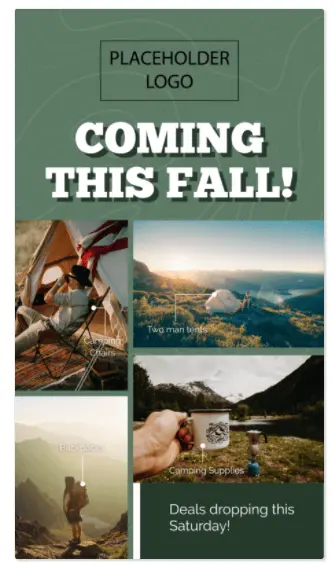
Get the Lucidpress Instagram story template HERE.
20. Count it down
Instagram Stories offers a customizable countdown sticker so you can celebrate no matter what the milestone. Product launches, sales, anniversaries, holidays, giveaways and events are all good fodder for the Instagram story countdown. Followers can also click on the sticker to set up an alert for when the count winds down.
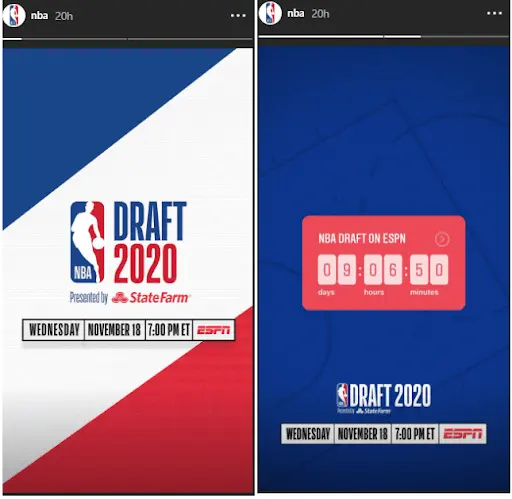
If you’re on autopilot periodically posting photos to your Instagram business profile, you’re missing out on the powerhouse of promotion this social media giant has become.
Learn how to leverage Instagram Stories and generate Instagram story ideas with Lucidpress Instagram story templates.